Definition of Antithesis
Examples of antithesis in everyday speech, common examples of antithesis from famous speeches, examples of proverbs featuring antithesis, utilizing antithesis in writing, antithesis and parallelism, antithesis and juxtaposition, use of antithesis in sentences , examples of antithesis in literature.
Antithesis is an effective literary device and figure of speech in which a writer intentionally juxtaposes two contrasting ideas or entities. Antithesis is typically achieved through parallel structure, in which opposing concepts or elements are paired in adjacent phrases , clauses , or sentences. This draws the reader’s attention to the significance or importance of the agents being contrasted, thereby adding a memorable and meaningful quality to the literary work.

Example 1: Hamlet (William Shakespeare)
Give every man thine ear, but few thy voice ; Take each man’s censure, but reserve thy judgment.
Example 2: Paradise Lost (John Milton)
Here at least We shall be free; the Almighty hath not built Here for his envy, will not drive us hence: Here we may reign secure, and in my choice To reign is worth ambition though in Hell: Better to reign in Hell, than serve in Heaven.
Example 3: Fire and Ice (Robert Frost)
Some say the world will end in fire, Some say in ice. From what I’ve tasted of desire I hold with those who favor fire. But if it had to perish twice, I think I know enough of hate To say that for destruction ice Is also great And would suffice.
In his poem, Frost utilizes antithesis to contrast fire and ice as elements with devastating and catastrophic potential to end the world. Frost effectively demonstrates the equal powers for the destruction of these elements, despite showcasing them as opposing forces. In this case, the poet’s antithesis has a literal as well as figurative interpretation. As the poem indicates, the world could literally end in the fire as well as ice. However, fire and ice are contrasting symbols in the poem as well. Fire represents “desire,” most likely in the form of greed, the corruption of power, domination, and control. Conversely, ice represents “hate” in the form of prejudice, oppression, neglect, and isolation.
Example 4: The Gettysburg Address by Abraham Lincoln
We have come to dedicate a portion of that field, as a final resting place for those who here gave their lives so that nation might live.
The brave men, living and dead, who struggled here, have consecrated it, far above our poor power to add or detract.
The world will little note, nor long remember what we say here, but it can never forget what they did here.
Function of Antithesis
Synonyms of antithesis, post navigation.

- Ask LitCharts AI
- Discussion Question Generator
- Essay Prompt Generator
- Quiz Question Generator

- Literature Guides
- Poetry Guides
- Shakespeare Translations
- Literary Terms

Antithesis Definition
What is antithesis? Here’s a quick and simple definition:
Antithesis is a figure of speech that juxtaposes two contrasting or opposing ideas, usually within parallel grammatical structures. For instance, Neil Armstrong used antithesis when he stepped onto the surface of the moon in 1969 and said, "That's one small step for a man, one giant leap for mankind." This is an example of antithesis because the two halves of the sentence mirror each other in grammatical structure, while together the two halves emphasize the incredible contrast between the individual experience of taking an ordinary step, and the extraordinary progress that Armstrong's step symbolized for the human race.
Some additional key details about antithesis:
- Antithesis works best when it is used in conjunction with parallelism (successive phrases that use the same grammatical structure), since the repetition of structure makes the contrast of the content of the phrases as clear as possible.
- The word "antithesis" has another meaning, which is to describe something as being the opposite of another thing. For example, "love is the antithesis of selfishness." This guide focuses only on antithesis as a literary device.
- The word antithesis has its origins in the Greek word antithenai , meaning "to oppose." The plural of antithesis is antitheses.
How to Pronounce Antithesis
Here's how to pronounce antithesis: an- tith -uh-sis
Antithesis and Parallelism
Often, but not always, antithesis works in tandem with parallelism . In parallelism, two components of a sentence (or pair of sentences) mirror one another by repeating grammatical elements. The following is a good example of both antithesis and parallelism:
To err is human , to forgive divine .
The two clauses of the sentence are parallel because each starts off with an infinitive verb and ends with an adjective ("human" and "divine"). The mirroring of these elements then works to emphasize the contrast in their content, particularly in the very strong opposite contrast between "human" and "divine."
Antithesis Without Parallelism
In most cases, antitheses involve parallel elements of the sentence—whether a pair of nouns, verbs, adjectives, or other grammar elements. However, it is also possible to have antithesis without such clear cut parallelism. In the Temptations Song "My Girl," the singer uses antithesis when he says:
"When it's cold outside , I've got the month of May ."
Here the sentence is clearly cut into two clauses on either side of the comma, and the contrasting elements are clear enough. However, strictly speaking there isn't true parallelism here because "cold outside" and "month of May" are different types of grammatical structures (an adjective phrase and a noun phrase, respectively).
Antithesis vs. Related Terms
Three literary terms that are often mistakenly used in the place of antithesis are juxtaposition , oxymoron , and foil . Each of these three terms does have to do with establishing a relationship of difference between two ideas or characters in a text, but beyond that there are significant differences between them.
Antithesis vs. Juxtaposition
In juxtaposition , two things or ideas are placed next to one another to draw attention to their differences or similarities. In juxtaposition, the pairing of two ideas is therefore not necessarily done to create a relationship of opposition or contradiction between them, as is the case with antithesis. So, while antithesis could be a type of juxtaposition, juxtaposition is not always antithesis.
Antithesis vs. Oxymoron
In an oxymoron , two seemingly contradictory words are placed together because their unlikely combination reveals a deeper truth. Some examples of oxymorons include:
- Sweet sorrow
- Cruel kindness
- Living dead
The focus of antithesis is opposites rather than contradictions . While the words involved in oxymorons seem like they don't belong together (until you give them deeper thought), the words or ideas of antithesis do feel like they belong together even as they contrast as opposites. Further, antitheses seldom function by placing the two words or ideas right next to one another, so antitheses are usually made up of more than two words (as in, "I'd rather be among the living than among the dead").
Antithesis vs. Foil
Some Internet sources use "antithesis" to describe an author's decision to create two characters in a story that are direct opposites of one another—for instance, the protagonist and antagonist . But the correct term for this kind of opposition is a foil : a person or thing in a work of literature that contrasts with another thing in order to call attention to its qualities. While the sentence "the hare was fast, and the tortoise was slow" is an example of antithesis, if we step back and look at the story as a whole, the better term to describe the relationship between the characters of the tortoise and the hare is "foil," as in, "The character of the hare is a foil of the tortoise."
Antithesis Examples
Antithesis in literature.
Below are examples of antithesis from some of English literature's most acclaimed writers — and a comic book!
Antithesis in Charles Dickens' A Tale of Two Cities
In the famous opening lines of A Tale of Two Cities , Dickens sets out a flowing list of antitheses punctuated by the repetition of the word "it was" at the beginning of each clause (which is itself an example of the figure of speech anaphora ). By building up this list of contrasts, Dickens sets the scene of the French Revolution that will serve as the setting of his tale by emphasizing the division and confusion of the era. The overwhelming accumulation of antitheses is also purposefully overdone; Dickens is using hyperbole to make fun of the "noisiest authorities" of the day and their exaggerated claims. The passage contains many examples of antithesis, each consisting of one pair of contrasting ideas that we've highlighted to make the structure clearer.
It was the best of times , it was the worst of times , it was the age of wisdom , it was the age of foolishness , it was the epoch of belief , it was the epoch of incredulity , it was the season of Light , it was the season of Darkness , it was the spring of hope , it was the winter of despair , we had everything before us, we had nothing before us, we were all going direct to Heaven , we were all going direct the other way —in short, the period was so far like the present period, that some of its noisiest authorities insisted on its being received, for good or for evil, in the superlative degree of comparison only.
Antithesis in John Milton's Paradise Lost
In this verse from Paradise Lost , Milton's anti-hero , Satan, claims he's happier as the king of Hell than he could ever have been as a servant in Heaven. He justifies his rebellion against God with this pithy phrase, and the antithesis drives home the double contrast between Hell and Heaven, and between ruling and serving.
Better to reign in Hell than serve in Heaven.
Antithesis in William Shakespeare's Othello
As the plot of Othello nears its climax , the antagonist of the play, Iago, pauses for a moment to acknowledge the significance of what is about to happen. Iago uses antithesis to contrast the two opposite potential outcomes of his villainous plot: either events will transpire in Iago's favor and he will come out on top, or his treachery will be discovered, ruining him.
This is the night That either makes me or fordoes me quite .
In this passage, the simple word "either" functions as a cue for the reader to expect some form of parallelism, because the "either" signals that a contrast between two things is coming.
Antithesis in William Shakespeare's Hamlet
Shakespeare's plays are full of antithesis, and so is Hamlet's most well-known "To be or not to be" soliloquy . This excerpt of the soliloquy is a good example of an antithesis that is not limited to a single word or short phrase. The first instance of antithesis here, where Hamlet announces the guiding question (" to be or not to be ") is followed by an elaboration of each idea ("to be" and "not to be") into metaphors that then form their own antithesis. Both instances of antithesis hinge on an " or " that divides the two contrasting options.
To be or not to be , that is the question: Whether 'tis nobler in the mind to suffer The slings and arrows of outrageous fortune Or to take arms against a sea of troubles, And by opposing end them ...
Antithesis in T.S. Eliot's "Four Quartets"
In this excerpt from his poem "Four Quartets," T.S. Eliot uses antithesis to describe the cycle of life, which is continuously passing from beginning to end, from rise to fall, and from old to new.
In my beginning is my end . In succession Houses rise and fall , crumble, are extended, Are removed, destroyed, restored, or in their place Is an open field, or a factory, or a by-pass. Old stone to new building , old timber to new fires ...
Antithesis in Green Lantern's Oath
Comic book writers know the power of antithesis too! In this catchy oath, Green Lantern uses antithesis to emphasize that his mission to defeat evil will endure no matter the conditions.
In brightest day , in blackest night , No evil shall escape my sight. Let those who worship evil's might Beware my power—Green lantern's light!
While most instances of antithesis are built around an "or" that signals the contrast between the two parts of the sentence, the Green Lantern oath works a bit differently. It's built around an implied "and" (to be technical, that first line of the oath is an asyndeton that replaces the "and" with a comma), because members of the Green Lantern corps are expressing their willingness to fight evil in all places, even very opposite environments.
Antithesis in Speeches
Many well-known speeches contain examples of antithesis. Speakers use antithesis to drive home the stakes of what they are saying, sometimes by contrasting two distinct visions of the future.
Antithesis in Patrick Henry's Speech to the Second Virginia Convention, 1775
This speech by famous American patriot Patrick Henry includes one of the most memorable and oft-quoted phrases from the era of the American Revolution. Here, Henry uses antithesis to emphasize just how highly he prizes liberty, and how deadly serious he is about his fight to achieve it.
Is life so dear, or peace so sweet, as to be purchased at the price of chains and slavery? Forbid it, Almighty God! I know not what course others may take: but as for me, give me liberty or give me death .
Antithesis in Martin Luther King Jr.'s Oberlin Commencement Address
In this speech by one of America's most well-known orators, antithesis allows Martin Luther King Jr. to highlight the contrast between two visions of the future; in the first vision, humans rise above their differences to cooperate with one another, while in the other humanity is doomed by infighting and division.
We must all learn to live together as brothers —or we will all perish together as fools .
Antithesis in Songs
In songs, contrasting two opposite ideas using antithesis can heighten the dramatic tension of a difficult decision, or express the singer's intense emotion—but whatever the context, antithesis is a useful tool for songwriters mainly because opposites are always easy to remember, so lyrics that use antithesis tend to stick in the head.
Antithesis in "Should I Stay or Should I Go" by The Clash (1981)
In this song by The Clash, the speaker is caught at a crossroads between two choices, and antithesis serves as the perfect tool to express just how confused and conflicted he is. The rhetorical question —whether to stay or to go—presents two opposing options, and the contrast between his lover's mood from one day (when everything is "fine") to the next (when it's all "black") explains the difficulty of his choice.
One day it's fine and next it's black So if you want me off your back Well, come on and let me know Should I stay or should I go ? Should I stay or should I go now? Should I stay or should I go now? If I go, there will be trouble If I stay it will be double ...
Antithesis in "My Girl" by the Temptations (1965)
In this song, the singer uses a pair of metaphors to describe the feeling of joy that his lover brings him. This joy is expressed through antithesis, since the singer uses the miserable weather of a cloudy, cold day as the setting for the sunshine-filled month of May that "his girl" makes him feel inside, emphasizing the power of his emotions by contrasting them with the bleak weather.
I've got sunshine on a cloudy day When it's cold outside I've got the month of May Well I guess you'd say, What can make me feel this way? My girl, my girl, my girl Talkin' bout my girl.
Why Do Writers Use Antithesis?
Fundamentally, writers of all types use antithesis for its ability to create a clear contrast. This contrast can serve a number of purposes, as shown in the examples above. It can:
- Present a stark choice between two alternatives.
- Convey magnitude or range (i.e. "in brightest day, in darkest night" or "from the highest mountain, to the deepest valley").
- Express strong emotions.
- Create a relationship of opposition between two separate ideas.
- Accentuate the qualities and characteristics of one thing by placing it in opposition to another.
Whatever the case, antithesis almost always has the added benefit of making language more memorable to listeners and readers. The use of parallelism and other simple grammatical constructions like "either/or" help to establish opposition between concepts—and opposites have a way of sticking in the memory.
Other Helpful Antithesis Resources
- The Wikipedia page on Antithesis : A useful summary with associated examples, along with an extensive account of antithesis in the Gospel of Matthew.
- Sound bites from history : A list of examples of antithesis in famous political speeches from United States history — with audio clips!
- A blog post on antithesis : This quick rundown of antithesis focuses on a quote you may know from Muhammad Ali's philosophy of boxing: "Float like a butterfly, sting like a bee."

- Climax (Figure of Speech)
- Figure of Speech
- Juxtaposition
- Parallelism
- Protagonist
- Rhetorical Question
- Falling Action
- Personification
- Antanaclasis
- Anachronism
- Dramatic Irony
- Tragic Hero
- Common Meter
- Formal Verse

- Quizzes, saving guides, requests, plus so much more.
- More from M-W
- To save this word, you'll need to log in. Log In
Definition of antithesis
Did you know.
Writers and speechmakers use the traditional pattern known as antithesis for its resounding effect; John Kennedy's famous "ask not what your country can do for you—ask what you can do for your country" is an example. But antithesis normally means simply "opposite". Thus, war is the antithesis of peace, wealth is the antithesis of poverty, and love is the antithesis of hate. Holding two antithetical ideas in one's head at the same time—for example, that you're the sole master of your fate but also the helpless victim of your terrible upbringing—is so common as to be almost normal.
Examples of antithesis in a Sentence
These examples are programmatically compiled from various online sources to illustrate current usage of the word 'antithesis.' Any opinions expressed in the examples do not represent those of Merriam-Webster or its editors. Send us feedback about these examples.
Word History
Late Latin, from Greek, literally, opposition, from antitithenai to oppose, from anti- + tithenai to set — more at do
1529, in the meaning defined at sense 1b(1)
Dictionary Entries Near antithesis
anti-theoretical
Cite this Entry
“Antithesis.” Merriam-Webster.com Dictionary , Merriam-Webster, https://www.merriam-webster.com/dictionary/antithesis. Accessed 20 Aug. 2024.
Kids Definition
Kids definition of antithesis, more from merriam-webster on antithesis.
Nglish: Translation of antithesis for Spanish Speakers
Britannica English: Translation of antithesis for Arabic Speakers
Britannica.com: Encyclopedia article about antithesis
Subscribe to America's largest dictionary and get thousands more definitions and advanced search—ad free!

Can you solve 4 words at once?
Word of the day.
See Definitions and Examples »
Get Word of the Day daily email!
Popular in Grammar & Usage
Plural and possessive names: a guide, 31 useful rhetorical devices, more commonly misspelled words, absent letters that are heard anyway, how to use accents and diacritical marks, popular in wordplay, 8 words for lesser-known musical instruments, it's a scorcher words for the summer heat, 7 shakespearean insults to make life more interesting, 10 words from taylor swift songs (merriam's version), 9 superb owl words, games & quizzes.

- Literary Terms
- Definition & Examples
- How to Use Antithesis
I. What is an Antithesis?
“Antithesis” literally means “opposite” – it is usually the opposite of a statement, concept, or idea. In literary analysis, an antithesis is a pair of statements or images in which the one reverses the other. The pair is written with similar grammatical structures to show more contrast. Antithesis (pronounced an-TITH-eh-sis) is used to emphasize a concept, idea, or conclusion.
II. Examples of Antithesis
That’s one small step for a man – one giant leap for mankind . (Neil Armstrong, 1969)
In this example, Armstrong is referring to man walking on the moon. Although taking a step is an ordinary activity for most people, taking a step on the moon, in outer space, is a major achievement for all humanity.
To err is human ; to forgive , divine . (Alexander Pope)
This example is used to point out that humans possess both worldly and godly qualities; they can all make mistakes, but they also have the power to free others from blame.
The world will little note , nor long remember , what we say here, but it can never forget what they did (Abraham Lincoln, The Gettysburg Address )
In his speech, Lincoln points out that the details of that moment may not be memorable, but the actions would make history, and therefore, never entirely forgotten.
Antithesis can be a little tricky to see at first. To start, notice how each of these examples is separated into two parts . The parts are separated either by a dash, a semicolon, or the word “but.” Antithesis always has this multi-part structure (usually there are two parts, but sometimes it can be more, as we’ll see in later examples). The parts are not always as obvious as they are in these examples, but they will always be there.
Next, notice how the second part of each example contains terms that reverse or invert terms in the first part: small step vs. giant leap; human vs. divine; we say vs. they do. In each of the examples, there are several pairs of contrasted terms between the first part and the second, which is quite common in antithesis.
Finally, notice that each of the examples contains some parallel structures and ideas in addition to the opposites. This is key! The two parts are not simply contradictory statements. They are a matched pair that have many grammatical structures or concepts in common; in the details, however, they are opposites.
For example, look at the parallel grammar of Example 1: the word “one,” followed by an adjective, a noun, and then the word “for.” This accentuates the opposites by setting them against a backdrop of sameness – in other words, two very different ideas are being expressed with very, very similar grammatical structures.
To recap: antithesis has three things:
- Two or more parts
- Reversed or inverted ideas
- (usually) parallel grammatical structure
III. The Importance of Verisimilitude
Antithesis is basically a complex form of juxtaposition . So its effects are fairly similar – by contrasting one thing against its opposite, a writer or speaker can emphasize the key attributes of whatever they’re talking about. In the Neil Armstrong quote, for example, the tremendous significance of the first step on the moon is made more vivid by contrasting it with the smallness and ordinariness of the motion that brought it about.
Antithesis can also be used to express curious contradictions or paradoxes. Again, the Neil Armstrong quote is a good example: Armstrong is inviting his listeners to puzzle over the fact that a tiny, ordinary step – not so different from the millions of steps we take each day – can represent so massive a technological accomplishment as the moon landing.
Paradoxically, an antithesis can also be used to show how two seeming opposites might in fact be similar.
IV. Examples of Verisimilitude in Literature
(adsbygoogle = window.adsbygoogle || []).push({}); Forgive us this day our trespasses as we forgive those who trespass against us . (The Lord’s Prayer)
The antithesis is doing a lot of work here. First, it shows the parallel between committing an evil act and being the victim of one. On the surface, these are opposites, and this is part of the antithesis, but at the same time they are, in the end, the same act from different perspectives. This part of the antithesis is basically just an expression of the Golden Rule.
Second, the antithesis displays a parallel between the speaker (a human) and the one being spoken to (God). The prayer is a request for divine mercy, and at the same time a reminder that human beings should also be merciful.
All the joy the world contains has come through wanting happiness for others . All the misery the world contains has come through wanting pleasure for yourself . (Shantideva, The Way of the Bodhisattva )
The antithesis here comes with some pretty intense parallel structure. Most of the words in each sentence are exactly the same as those in the other sentence. (“All the ___ the world contains has come through wanting ____ for ____.”) This close parallel structure makes the antithesis all the more striking, since the words that differ become much more visible.
Another interesting feature of this antithesis is that it makes “pleasure” and “happiness” seem like opposites, when most of us might think of them as more or less synonymous. The quote makes happiness seem noble and exalted, whereas pleasure is portrayed as selfish and worthless.
The proper function of man is to live , not to exist . I shall not waste my days in trying to prolong (Jack London, Credo )
The opening antithesis here gets its punch from the fact that we think of living and existing as pretty similar terms. But for London, they are opposites. Living is about having vivid experiences, learning, and being bold; simply existing is a dull, pointless thing. These two apparently similar words are used in this antithesis to emphasize the importance of living as opposed to mere existing.
The second antithesis, on the other hand, is just the opposite – in this case, London is taking two words that seem somewhat opposed (waste and prolong), and telling us that they are in fact the same . Prolonging something is making it last; wasting something is letting it run out too soon. But, says London, when it comes to life, they are the same. If you try too hard to prolong your days (that is, if you’re so worried about dying that you never face your fears and live your life), then you will end up wasting them because you will never do anything worthwhile.
V. Examples of Verisimilitude in Pop Culture
Everybody doesn’t like something, but nobody doesn’t like Sara Lee. (Sara Lee pastry advertisement)
This classic ad uses antithesis to set up a deliberate grammatical error. This is a common technique in advertising, since people are more likely to remember a slogan that is grammatically incorrect. (Even if they only remember it because they found it irritating, it still sticks in their brain, which is all that an ad needs to do.) The antithesis helps make the meaning clear, and throws the grammatical error into sharper relief.
What men must know , a boy must learn . (The Lookouts)
Here’s another example of how parallel structure can turn into antithesis fairly easily. (The structure is noun-“must”-verb. ) The antithesis also expresses the basic narrative of The Lookouts , which is all about kids learning to fend for themselves and become full-fledged adults.
Shut Your Mouth and Open Your Eyes (the band “AFI” – album title)
The antithesis here is a juxtaposition of two different actions (opening and shutting) that are actually part of the same sort of behavior – the behavior of somebody who wants to understand the world rather than be the center of attention. It’s basically a restatement of the old adage that “those who speak the most often have the least to say.”
VI. Related Terms
- Juxtaposition
Antithesis is basically a form of juxtaposition . Juxtaposition, though, is a much broader device that encompasses any deliberate use of contrast or contradiction by an author. So, in addition to antithesis, it might include:
- The scene in “The Godfather” where a series of brutal murders is intercut with shots of a baptism, juxtaposing birth and death.
- “A Song of Ice and Fire” (George R. R. Martin book series)
- Heaven and Hell
- Mountains and the sea
- Dead or alive
- “In sickness and in health”
Antithesis performs a very similar function, but does so in a more complicated way by using full sentences (rather than single words or images) to express the two halves of the juxtaposition.
Here is an antithesis built around some of the common expressions from above
- “ Sheep go to Heaven ; goats go to Hell .”
- “Beethoven’s music is as mighty as the mountains and as timeless as the sea .”
- “In sickness he loved me; in health he abandoned ”
Notice how the antithesis builds an entire statement around the much simpler juxtaposition. And, crucially, notice that each of those statements exhibits parallel grammatical structure . In this way, both Juxtaposition and parallel structures can be used to transform a simple comparison, into antithesis.
List of Terms
- Alliteration
- Amplification
- Anachronism
- Anthropomorphism
- Antonomasia
- APA Citation
- Aposiopesis
- Autobiography
- Bildungsroman
- Characterization
- Circumlocution
- Cliffhanger
- Comic Relief
- Connotation
- Deus ex machina
- Deuteragonist
- Doppelganger
- Double Entendre
- Dramatic irony
- Equivocation
- Extended Metaphor
- Figures of Speech
- Flash-forward
- Foreshadowing
- Intertextuality
- Literary Device
- Malapropism
- Onomatopoeia
- Parallelism
- Pathetic Fallacy
- Personification
- Point of View
- Polysyndeton
- Protagonist
- Red Herring
- Rhetorical Device
- Rhetorical Question
- Science Fiction
- Self-Fulfilling Prophecy
- Synesthesia
- Turning Point
- Understatement
- Urban Legend
- Verisimilitude
- Essay Guide
- Cite This Website

What is Antithesis? Definition, Examples of Antitheses in Writing
Home » The Writer’s Dictionary » What is Antithesis? Definition, Examples of Antitheses in Writing
Antithesis definition: Antithesis is a literary and rhetorical device where two seemingly contrasting ideas are expressed through parallel structure.
What is Antithesis?
What does antithesis mean? An antithesis is just that—an “anti” “thesis.” An antithesis is used in writing to express ideas that seem contradictory.
An antithesis uses parallel structure of two ideas to communicate this contradiction.
Example of Antithesis:
- “Float like a butterfly, sting like a bee.” –Muhammad Ali

First, the structure is parallel. Each “side” of the phrase has the same number of words and the same structure. Each uses a verb followed by a simile.
Second, the contracting elements of a butterfly and a bee seem contradictory. That is, a butterfly is light and airy while a bee is sharp and stinging. One person (a boxer, in this case) should not be able to possess these two qualities—this is why this is an antithesis.
However, Ali is trying to express how a boxer must be light on his feet yet quick with his fist.
Modern Examples of Antithesis

- “That’s one small step for man, one giant leap for mankind.”
Through parallel structure, this quotation presents an antithesis. It seems contradictory that one action could be a “small step” and a “giant leap.”
However, this contradiction proposes that the action of landing on the moon might have just been a small physical step for the man Neil Armstrong, but it was a giant leap for the progress of mankind.
The Function of Antithesis

An antithesis stands out in writing. Because it uses parallel structure, an antithesis physically stands out when interspersed among other syntactical structures. Furthermore, an antithesis presents contrasting ideas that cause the reader or audience to pause and consider the meaning and purpose.
Oftentimes, the meaning of an antithesis is not overtly clear. That is, a reader or audience must evaluate the statement to navigate the meaning.
Writers utilize antitheses very sparingly. Since its purpose is to cause an audience to pause and consider the argument, it must be used with purpose and intent.
Antithesis Example from Literature

- “It was the best of times, it was the worst of times, it was the age of wisdom, it was the age of foolishness, it was the epoch of belief, it was the epoch of incredulity…”
From the beginning, Dickens presents two contradictory ideas in this antithesis.
How can it be the “best” and the “worst” of times? These two “times” should not be able to coexist.
Similarly, how can the setting of this novel also take place during an “age of wisdom” and an “age of foolishness?”
The antithesis continues.
Dickens opens his with these lines to set the tone for the rest of the novel. Clearly, there are two sides to this story, two tales of what is the truth. These two “sides” should not function peacefully. And, in fact, they do not. That, after all, is the “tale of two cities.”
Dickens sets up this disparity to set the tone for his novel, which will explore this topic.
Summary: What is an Antithesis?
Define antithesis: An antithesis consists of contrasting concepts presented in parallel structure.
Writers use antithesis to create emphasis to communicate an argument.
- Note: The plural form of antithesis is antitheses.
Literary Devices
Literary devices, terms, and elements, definition of antithesis, difference between antithesis and juxtaposition, common examples of antithesis, significance of antithesis in literature, examples of antithesis in literature.
HAMLET: To be, or not to be, that is the question— Whether ’tis Nobler in the mind to suffer The Slings and Arrows of outrageous Fortune, Or to take Arms against a Sea of troubles, And by opposing, end them?
( Hamlet by William Shakespeare)
It was the best of times, it was the worst of times, it was the age of wisdom, it was the age of foolishness, it was the epoch of belief, it was the epoch of incredulity, it was the season of Light, it was the season of Darkness, it was the spring of hope, it was the winter of despair, we had everything before us, we had nothing before us, we were all going direct to Heaven, we were all going direct the other way…
( A Tale of Two Cities by Charles Dickens)
There was only one catch and that was Catch-22, which specified that a concern for one’s own safety in the face of dangers that were real and immediate was the process of a rational mind. Orr was crazy and could be grounded. All he had to do was ask; and as soon as he did, he would no longer be crazy and would have to fly more missions. Orr would be crazy to fly more missions and sane if he didn’t, but if he was sane he had to fly them. If he flew them he was crazy and didn’t have to; but if he didn’t want to he was sane and had to. Yossarian was moved very deeply by the absolute simplicity of this clause of Catch-22 and let out a respectful whistle.
This case is not a difficult one, it requires no minute sifting of complicated facts, but it does require you to be sure beyond all reasonable doubt as to the guilt of the defendant.
( To Kill a Mockingbird by Harper Lee)
In Harper Lee’s novel To Kill a Mockingbird , Atticus Finch is a lawyer representing Tom Robinson. Atticus presents the above statement to the jury, setting up an antithesis. He asserts that the case is not difficult and yet requires the jury to be absolutely sure of their decision. Atticus believes the case to have a very obvious conclusion, and hopes that the jury will agree with him, but he is also aware of the societal tensions at work that will complicate the case.
Test Your Knowledge of Antithesis
WITCHES: Fair is foul, and foul is fair: Hover through the fog and filthy air.
MACBETH: Is this a dagger which I see before me, The handle toward my hand?
WITCHES: Something wicked this way comes.
4. Which of the following quotes from Heller’s Catch-22 contains an example of antithesis? A. There are now fifty or sixty countries fighting in this war. Surely so many counties can’t all be worth dying for. B. He had decided to live forever or die in the attempt, and his only mission each time he went up was to come down alive. C. You’re inches away from death every time you go on a mission. How much older can you be at your age? [spoiler title=”Answer to Question #4″] Answer: B is the correct answer.[/spoiler]
- Daily Crossword
- Word Puzzle
- Word Finder
- Word of the Day
- Synonym of the Day
- Word of the Year
- Language stories
- All featured
- Gender and sexuality
- All pop culture
- Writing hub
- Grammar essentials
- Commonly confused
- All writing tips
- Pop culture
- Writing tips
Advertisement
[ an- tith - uh -sis ]
the antithesis of right and wrong.
Her behavior was the very antithesis of cowardly.
Synonyms: reverse , opposite
- the placing of a sentence or one of its parts against another to which it is opposed to form a balanced contrast of ideas, as in “Give me liberty or give me death.”
- the second sentence or part thus set in opposition, as “or give me death.”
- Philosophy. Hegelian dialectic
/ ænˈtɪθɪsɪs /
- the exact opposite
- contrast or opposition
- rhetoric the juxtaposition of contrasting ideas, phrases, or words so as to produce an effect of balance, such as my words fly up, my thoughts remain below
- philosophy the second stage in the Hegelian dialectic contradicting the thesis before resolution by the synthesis
Other Words From
- self-an·tithe·sis noun
Word History and Origins
Origin of antithesis 1
Example Sentences
In the Democratic primary in his home state, he was humiliated by his old antithesis Wallace, who beat him decisively.
It cannot be stressed enough that the behavior of the sitting president is the antithesis of the ideals of American democracy, institutions or peaceful transitions.
American Christians may have chosen cynicism in 2016, but cynicism is the antithesis of the Christian faith, and cynicism won’t have the final word in America, either.
The transhuman cannot exist outside of ubuntu, of course, which is the antithesis of the colonial order for a number of reasons.
Tesla’s being touted as a go-go player in the antithesis of a go-go sector.
Belle Knox is the antithesis of Jenna Jameson—and not just in looks.
To me this is the antithesis of what travel should be about.
Married at First Sight is the antithesis of The Bachelor and The Bachelorette.
Yet its sound is the musical antithesis of a blended Frappuccino.
Now Joffrey, the Starks' black-hearted antithesis, has met a similar fate.
If you did fail, you would try Exclusion, and you would find nothing which is the antithesis of the area of New York.
Thus seen, socialism appeared as the very antithesis of law and order, of love and chastity, and of religion itself.
There is, however, but little danger of overdoing the parallel construction where there is no antithesis.
Nor is it to be wondered at, if we consider the antithesis which is presented to their usual mode of life.
He is a sentimental Classicist, and his subjects the antithesis of the Grco-Roman ideal to which he does homage in his technique.

What is Antithesis? Examples of Antithesis in Literature and Speech
Antithesis is a rhetorical device that has been used for centuries to create contrast and emphasize ideas in speech and writing. It involves placing two contrasting ideas side by side, often using parallel grammatical structures, to highlight their differences. This technique can be used for various purposes, such as to create emphasis, create balance, or to make a point.
Table of Contents
Definition of Antithesis
Antithesis is a literary device that involves contrasting two opposing ideas or concepts in a sentence or passage in order to create a dramatic or rhetorical effect. The word “antithesis” comes from the Greek word “antithenai,” which means “to oppose.”
Antithesis can be used in a variety of ways, including through contrasting words, phrases, or clauses. This technique is often used in poetry, prose, and speeches to create a sense of tension and to emphasize the differences between two ideas.
In antithesis, two contrasting ideas are placed side by side in order to highlight their differences. This technique is often used to create a sense of balance in a sentence or passage. For example, consider the following sentence: “To be or not to be, that is the question.” In this sentence, the opposing ideas of existence and non-existence are contrasted in order to create a sense of tension and to emphasize the importance of the decision at hand.
Examples of Antithesis
Antithesis is a literary device that involves the use of contrasting ideas, words, or phrases in a parallel structure. Here are some examples of antithesis in literature, speeches, and advertising.
Antithesis in Literature
Antithesis is commonly used in literature to highlight the contrast between two opposing ideas or themes. One of the most famous examples of antithesis in literature is found in Charles Dickens’ A Tale of Two Cities . The opening lines of the novel read:
“It was the best of times, it was the worst of times, it was the age of wisdom, it was the age of foolishness, it was the epoch of belief, it was the epoch of incredulity, it was the season of Light, it was the season of Darkness, it was the spring of hope, it was the winter of despair, we had everything before us, we had nothing before us, we were all going direct to Heaven, we were all going direct the other way – in short, the period was so far like the present period, that some of its noisiest authorities insisted on its being received, for good or for evil, in the superlative degree of comparison only.”
The contrasting ideas of “best” and “worst,” “wisdom” and “foolishness,” “belief” and “incredulity,” and others are used to emphasize the stark differences between the two cities.
Antithesis in Speeches
Antithesis is also commonly used in speeches to create a memorable impact on the audience. One of the most famous examples of antithesis in a speech is from Martin Luther King Jr.’s “I Have a Dream” speech:
“We must learn to live together as brothers or perish together as fools.”
The contrasting ideas of “live together” and “perish together” are used to emphasize the importance of unity and brotherhood.
Antithesis in Advertising
Antithesis is also used in advertising to create memorable slogans and taglines. One example is the slogan for the car company BMW:
“The ultimate driving machine.”
The contrasting ideas of “ultimate” and “driving machine” are used to emphasize the high quality and performance of BMW cars.
In conclusion, antithesis is a powerful literary device that can be used in a variety of contexts to create memorable and impactful statements.
Antithesis vs. Juxtaposition
Antithesis and juxtaposition are two rhetorical devices that are often used in literature and speech. While they may seem similar, there are distinct differences between the two.
Antithesis is a rhetorical device that involves placing two contrasting ideas side by side in a sentence or phrase. The purpose of antithesis is to create a stark contrast between the two ideas, often to emphasize a point or to create a sense of tension or conflict.
For example, one famous example of antithesis comes from Charles Dickens’ “A Tale of Two Cities”: “It was the best of times, it was the worst of times.” This sentence contrasts two opposing ideas, highlighting the extreme differences between them.
Antithesis is often used in speeches and persuasive writing to create a memorable and impactful statement. However, it can also be used in more subtle ways to add depth and complexity to a piece of writing.
Juxtaposition
Juxtaposition, on the other hand, involves placing two ideas or objects next to each other in order to highlight their differences or similarities. Unlike antithesis, the two ideas or objects may not necessarily be opposing or contrasting.
For example, a writer might use juxtaposition to describe two characters in a story. By placing their descriptions side by side, the writer can highlight their differences and create a more vivid picture of each character.
Juxtaposition can also be used to create irony or humor. By placing two unlikely ideas or objects next to each other, a writer can create a sense of surprise or amusement.
In conclusion, while antithesis and juxtaposition are both rhetorical devices that involve placing two ideas or objects next to each other, they serve different purposes. Antithesis is used to create a contrast or conflict between two opposing ideas, while juxtaposition is used to highlight the differences or similarities between two ideas or objects.
Antithesis in Communication
Antithesis is a powerful tool in communication that can be used to emphasize contrast, create memorable phrases, and strengthen arguments. By juxtaposing two opposing ideas, antithesis can help to clarify and highlight the differences between them, making them more easily understood and remembered. In this section, we will explore the importance of antithesis in communication and how it can be used effectively.
Emphasizing Contrast
One of the primary functions of antithesis is to emphasize contrast. By placing two opposing ideas side by side, antithesis can draw attention to their differences and make them more apparent. This can be especially useful in situations where it is important to distinguish between two similar but distinct concepts. For example, in political discourse, antithesis can be used to highlight the differences between two competing policy proposals or ideologies.
Creating Memorable Phrases
Another important function of antithesis is to create memorable phrases. By using contrasting ideas in a sentence or phrase, antithesis can create a sense of balance and rhythm that can make the words more memorable. This can be seen in famous quotes such as “To be or not to be” from Shakespeare’s Hamlet, which uses antithesis to create a memorable phrase that encapsulates the play’s central theme.
Strengthening Arguments
Finally, antithesis can be used to strengthen arguments. By using contrasting ideas, antithesis can help to make an argument more persuasive by highlighting the strengths of one idea while pointing out the weaknesses of another. This can be especially useful in situations where it is important to make a convincing case, such as in a legal argument or a political debate.
In conclusion, antithesis is an important tool in communication that can be used to emphasize contrast, create memorable phrases, and strengthen arguments. By using contrasting ideas, antithesis can help to clarify and highlight the differences between two concepts, making them more easily understood and remembered. Whether in literature, politics, or everyday conversation, antithesis can be a powerful tool for effective communication.
Overall, antithesis is a valuable tool for writers and speakers who want to create a sense of contrast and emphasize their point. When used effectively, it can make writing or speech more memorable and impactful. However, it is important to use it in moderation and not rely on it too heavily. By understanding how to use antithesis effectively, writers and speakers can take their communication skills to the next level.
Related Links
- Verbal Irony
- English Grammar
- Figures Of Speech
Antithesis: Meaning, Definition and Examples
Figures of speech , otherwise known as rhetorical devices, are used in the English language to beautify and make your language look and sound a lot more effective rather than a literal presentation of information. Each figure of speech has its function and is meant to perform its roles giving the context a unique effect. In this article, you will learn about one such figure of speech called antithesis. Read through the article to learn more about what antithesis is, its definition and how it differs from an oxymoron. You can also check out the examples and analyse how it is written for an in-depth understanding of the same.
Table of Contents
What is antithesis – meaning and definition, what differentiates an antithesis from an oxymoron, some common examples of antithesis, frequently asked questions on antithesis.
An antithesis is a figure of speech that states strongly contrasting ideas placed in juxtaposition. They contain compound sentences with the two independent clauses separated by a comma or a semicolon , in most cases. However, there are also instances where the antithesis is a compound sentence with a conjunction . An antithesis is mainly used to portray the stark difference between the two opposing ideas.
Antithesis, according to the Oxford Learner’s Dictionary, is defined as “a contrast between two things”, and according to the Cambridge Dictionary, “a difference or opposition between two things”. The Merriam-Webster Dictionary gives a more explanatory definition. According to it, antithesis is “the rhetorical contrast of ideas by means of parallel arrangements of words, clauses, or sentences”.
Knowing the difference between an antithesis and an oxymoron will help you comprehend and use both the rhetorical devices effectively. Take a look at the table given below to learn more.
|
|
|
| in juxtaposition. | to produce an effect. |
Here are some of the most common examples of antithesis for your reference.
- Hope for the best; prepare for the worst.
- Keep your mouth closed and your eyes open.
- “It was the best of times, it was the worst of times. It was the age of wisdom, it was the age of foolishness.” – Charles Dickens
- “That’s one small step for a man, one giant leap for mankind.” – Neil Armstrong
- “Better to reign in Hell, than to serve in Heaven.” – John Milton
- Speech is silver, but silence is gold.
- “Give every man thy ear, but few thy voice.” – William Shakespeare
- Keep your friends close; keep your enemies closer.
- “To err is human; to forgive divine.” – Alexander Pope
- Money is the root of all evil: poverty is the fruit of all goodness.
What is antithesis?
An antithesis is a figure of speech that states strongly contrasting ideas placed in juxtaposition. They contain compound sentences with the two independent clauses separated by a comma or a semicolon, in most cases. However, there are also instances where the antithesis is a compound sentence with a conjunction.
What is the definition of antithesis?
What is the difference between antithesis and oxymoron.
The main difference between an antithesis and an oxymoron is that antithesis refers to the use of two contrasting ideas or thoughts conveyed in two independent clauses placed in juxtaposition, separated by a comma, a semicolon or a conjunction; whereas, the term ‘oxymoron’ refers to the use of two opposite words within a phrase to create an effect.
Give some examples of antithesis.
Here are a few examples of antithesis for your reference.
- “Love is an ideal thing, marriage a real thing.” – Goethe
- “Folks who have no vices have very few virtues.” – Abraham Lincoln
- “Man proposes, God disposes.”
- Beggars can’t be choosers.
- Be slow in choosing, but slower in changing.
| ENGLISH Related Links | |
Leave a Comment Cancel reply
Your Mobile number and Email id will not be published. Required fields are marked *
Request OTP on Voice Call
Post My Comment
Register with BYJU'S & Download Free PDFs
Register with byju's & watch live videos.
Antithesis Definition Antithesis, which literally means “opposite,” is a rhetorical device wherein opposite thoughts are prepare in a sentence to obtain a contrasting effect. Antithesis emphasizes the idea of assessment through parallel structures of the contrasted terms or clauses. The structures of terms and clauses are similar, so that it will draw the attention of the listeners or readers. For example: “Setting foot on the moon may be a small step for a person but a giant step for mankind.” The use of contrasting thoughts, “a small step” and “a massive step,” within the sentence above emphasizes the importance of one of the most important landmarks of human history. Common Antithesis Examples Some well-known antithetical statements have become part of our everyday speech, and are regularly used in arguments and discussions. Below is a listing of some commonplace antithetical statements: Give every man thy ear, however few thy voice. Man proposes, God disposes. Love is a really perfect thing, marriage a actual thing. Speech is silver, but silence is gold. Patience is bitter, however it has a sweet fruit. Money is the foundation of all evil: poverty is the fruit of all goodness. You are smooth on the eyes, but tough on the heart. Examples of Antithesis in Literature In literature, writers rent antithesis not simplest in sentences, but additionally in characters and events. Thus, its use is extensive. Below are a few examples of antithesis in literature: Example #1: A Tale of Two Cities (By Charles Dickens) The establishing lines of Charles Dickens’ novel A Tale of Two Cities provides an unforgettable antithesis example: “It become the first-class of times, it become the worst of times, it became the age of wisdom, it was the age of foolishness, it become the epoch of belief, it turned into the epoch of incredulity, it changed into the season of Light, it was the season of Darkness, it changed into the spring of hope, it was the wintry weather of despair, we had everything before us, we had nothing earlier than us, we were all going direct to Heaven, we were all going direct the opposite way.” The contrasting thoughts, set in parallel structures, markedly spotlight the battle that existed within the time discussed in the novel. Example #2: Julius Caesar (By William Shakespeare) In William Shakespeare’s Julius Caesar, we note antithesis within the characters of Mark Antony and Marcus Brutus. Brutus is portrayed as the “noblest of Romans,” near Caesar, and someone who cherished Rome and Caesar. Antony, at the contrary, is proven as a person with the evil intentions of harming Caesar, and taking charge of Rome. These antithetical characters spotlight the battle inside the play. Example #3: An Essay on Criticism (By Alexander Pope) Alexander Pope, in his An Essay on Criticism, says: “To err is human; to forgive divine.” Fallibility is a trait of humans, and God – the Creator – is most forgiving. Through those antithetical thoughts, Pope exhibits the simple nature of human beings. He wants to say that God is forgiving because his creation is erring. Example #4: Community (By John Donne) We find antithesis in John Donne’s poem Community: “Good we must love, and must hate ill, For unwell is ill, and correct desirable still; But there are things indifferent, Which we may neither hate, nor love, But one, and then another prove, As we shall discover our fancy bent.” Two contrasting words “love” and “hate” are combined within the above lines. It emphasizes that we love right due to the fact it is always top, and we hate bad due to the fact it's far always bad. It is a matter of desire to love or hate things that are neither good nor bad. Example #5: Paradise Lost (By John Milton) John Milton, in Paradise Lost, says: “Better to reign in Hell than serve in Heav’n.” The contrasting thoughts of reign/serve, and Hell/Heav’n are positioned on this sentence to acquire an antithetical effect. Function of Antithesis A literary tool, like antithesis, makes use of phrases to convey ideas in exceptional methods from the commonplace words and expressions of daily life. Thus, it conveys meaning greater vividly than regular speech. When contrasting thoughts are brought together, the concept is expressed extra emphatically. As a literary device, antithesis makes contrasts in an effort to observe pros and cons of a subject below discussion, and facilitates to bring on judgment on that precise subject.
- Alliteration
- Anachronism
- Antimetabole
- Aposiopesis
- Characterization
- Colloquialism
- Connotation
- Deus Ex Machina
- Didacticism
- Doppelganger
- Double Entendre
- Flash Forward
- Foreshadowing
- Internal Rhyme
- Juxtaposition
- Non Sequitur
- Onomatopoeia
- Parallelism
- Pathetic Fallacy
- Personification
- Poetic Justice
- Point of View
- Portmanteau
- Protagonist
- Red Herring
- Superlative
- Synesthesia
- Tragicomedy
- Tragic Flaw
- Verisimilitude
Antithesis (Grammar and Rhetoric)
Glossary of Grammatical and Rhetorical Terms
Richard Nordquist
- An Introduction to Punctuation
- Ph.D., Rhetoric and English, University of Georgia
- M.A., Modern English and American Literature, University of Leicester
- B.A., English, State University of New York
Antithesis is a rhetorical term for the juxtaposition of contrasting ideas in balanced phrases or clauses . Plural: antitheses . Adjective: antithetical .
In grammatical terms, antithetical statements are parallel structures .
"A perfectly formed antithesis," says Jeanne Fahnestock, combines " isocolon , parison , and perhaps, in an inflected language, even homoeoteleuton ; it is an overdetermined figure . The aural patterning of the antithesis, its tightness and predictability, are critical to appreciating how the syntax of the figure can be used to force semantic opposites" ( Rhetorical Figures in Science , 1999).
From the Greek, "opposition"
Examples and Observations
- "Love is an ideal thing, marriage a real thing." (Goethe)
- "Everybody doesn't like something, but nobody doesn't like Sara Lee." (advertising slogan)
- "There are so many things that we wish we had done yesterday, so few that we feel like doing today." (Mignon McLaughlin, The Complete Neurotic's Notebook . Castle Books, 1981)
- "We notice things that don't work. We don't notice things that do. We notice computers, we don't notice pennies. We notice e-book readers, we don't notice books." (Douglas Adams, The Salmon of Doubt: Hitchhiking the Galaxy One Last Time . Macmillan, 2002)
- "Hillary has soldiered on, damned if she does, damned if she doesn't, like most powerful women, expected to be tough as nails and warm as toast at the same time." (Anna Quindlen, "Say Goodbye to the Virago." Newsweek , June 16, 2003)
- "It was the best of times, it was the worst of times, it was the age of wisdom, it was the age of foolishness, it was the epoch of belief, it was the epoch of incredulity, it was the season of Light, it was the season of Darkness, it was the spring of hope, it was the winter of despair, we had everything before us, we had nothing before us, we were all going direct to Heaven, we were all going direct the other way." (Charles Dickens, A Tale of Two Cities , 1859)
- "Tonight you voted for action, not politics as usual. You elected us to focus on your jobs, not ours." (President Barack Obama, election night victory speech, November 7, 2012)
- "You're easy on the eyes Hard on the heart." (Terri Clark)
- "We must learn to live together as brothers or perish together as fools." (Martin Luther King, Jr., speech at St. Louis, 1964)
- "The world will little note, nor long remember what we say here, but it can never forget what they did here." (Abraham Lincoln, The Gettysburg Address , 1863)
- "All the joy the world contains Has come through wishing happiness for others. All the misery the world contains Has come through wanting pleasure for oneself." (Shantideva)
- "The more acute the experience, the less articulate its expression." (Harold Pinter, "Writing for the Theatre," 1962)
- "And let my liver rather heat with wine Than my heart cool with mortifying groans." (Gratiano in The Merchant of Venice by William Shakespeare)
- Jack London's Credo "I would rather be ashes than dust! I would rather that my spark should burn out in a brilliant blaze than it should be stifled by dryrot. I would rather be a superb meteor, every atom of me in magnificent glow, than a sleepy and permanent planet. The proper function of man is to live, not to exist. I shall not waste my days in trying to prolong them. I shall use my time." (Jack London, quoted by his literary executor, Irving Shepard, in an introduction to a 1956 collection of London's stories)
- Antithesis and Antitheton " Antithesis is the grammatical form of antitheton . Antitheton deals with contrasting thoughts or proofs in an argument ; Antithesis deals with contrasting words or ideas within a phrase, sentence, or paragraph." (Gregory T. Howard, Dictionary of Rhetorical Terms . Xlibris, 2010)
- Antithesis and Antonyms Antithesis as a figure of speech exploits the existence of many 'natural' opposites in the vocabularies of all languages. Small children filling in workbooks and adolescents studying for the antonyms section of the SAT learn to match words to their opposites and so absorb much vocabulary as pairs of opposed terms, connecting up to down and bitter to sweet, pusillanimous to courageous and ephemeral to everlasting. Calling these antonyms 'natural' simply means that pairs of words can have wide currency as opposites among users of a language outside any particular context of use. Word association tests give ample evidence of the consistent linking of opposites in verbal memory when subjects given one of a pair of antonyms most often respond with the other, 'hot' triggering 'cold' or 'long' retrieving 'short' (Miller 1991, 196). An antithesis as a figure of speech at the sentence level builds on these powerful natural pairs, the use of one in the first half of the figure creating the expectation of its verbal partner in the second half." (Jeanne Fahnestock, Rhetorical Figures in Science . Oxford University Press, 1999)
- Antithesis in Films - "Since . . . the quality of a scene or image is more vividly shown when set beside its opposite, it is not surprising to find antithesis in film . . .. There is a cut in Barry Lyndon (Stanley Kubrick) from the yellow flickers of a flaming house to a still gray courtyard, lined with soldiers, and another from the yellow candles and warm browns of a gambling room to the cool grays of a terrace by moonlight and the Countess of Lyndon in white." (N. Roy Clifton, The Figure in Film . Associated University Presses, 1983) "It is clear that in every simile there is present both differences and likenesses, and both are a part of its effect. By ignoring differences, we find a simile and may perhaps find an antithesis in the same event, by ignoring likeness. . . . - "In The Lady Eve (Preston Sturges), a passenger boards a liner by tender. This was conveyed by the two vessels' whistling. We see a convulsive spurt of water and hear a desperate, soundless puff before the siren of the tender found its voice. There was a stuttering amazement, a drunken incoordination to these elaborate preliminaries, foiled by the liner's lofty unruffled burst of sounding steam. Here things that are like, in place, in sound, and in function, are unexpectedly contrasted. The commentary lies in the differences and gains force from the likeness." (N. Roy Clifton, The Figure in Film . Associated University Presses, 1983)
- Antithetical Observations of Oscar Wilde - “When we are happy, we are always good, but when we are good, we are not always happy.” ( The Picture of Dorian Gray , 1891) - “We teach people how to remember, we never teach them how to grow.” ("The Critic as Artist," 1991) - “Wherever there is a man who exercises authority, there is a man who resists authority.” ( The Soul of Man Under Socialism , 1891) - “Society often forgives the criminal; it never forgives the dreamer.” ("The Critic as Artist," 1991)
Pronunciation: an-TITH-uh-sis
- What Are Tropes in Language?
- Chiasmus Figure of Speech
- Euphuism (Prose Style)
- Scheme (Rhetoric): Definition and Examples
- How to Form a Balanced Sentence
- presence (rhetoric)
- Isocolon: A Rhetorical Balancing Act
- What Is a Maxim?
- The Art of Public Speaking
- Decorum in Rhetoric
- Syncrisis (Rhetoric) Definition and Examples
- Antimetabole: Figure of Speech
- Rhetorical Move
- Logos (Rhetoric)

- Scriptwriting
What is Antithesis — Definition & Examples in Literature & Film
I f you’ve ever heard sentence structure, met characters, or witnessed ideas that seem diametrically opposed, you’re actually pretty familiar with the idea of the antithesis. But there is more to it than just juxtaposing ideas. Read on to learn exactly what is antithesis, how this tool is used, and how you can include an antithesis in your next project.
Antithesis Definition
First, let’s define antithesis.
There are a number of terms often confused for antithesis (like paradox or oxymoron ). But an antithesis has a particular grammatical structure that helps differentiate it from the rest. So, here’s the antithesis definition and then we'll look at specific examples:
ANTITHESIS DEFINITION
What is antithesis.
An antithesis is a rhetorical and literary device with parallel grammar structure but which establishes a nearly complete or exact opposition in ideas or characters. It can be effective in emphasizing drastic differences between opposing concepts.
How to pronounce antithesis: [an-TITH-uh-sis]
Familiar antithesis examples:
- “That’s one small step for man, one giant leap for mankind.”
- “No pain, no gain.”
- “Out of sight, out of mind.”
The word “antithesis” comes from the Greek word meaning “setting opposite,” which is an idea that has been used in various forms. Let’s look at those various forms in more antithesis examples.
Antitheses Examples
How do we use antithesis today.
The purpose of antithetical language is not just mentioning the existence of opposing ideas, but rather emphasizing the stark differences between them. The often lyrical and rhythmic nature of this device helps accentuate the parallel grammatical structure.
Watch the video below to learn more about how we use antitheses today.
Antithesis Definition, Examples and Techniques
We use this device in that pure form today (see the examples above) in everyday turns of phrase. But there are more in-depth ways (in actions and story in general) that fit the antithesis definition.
People and characters can act in an antithetical manner to their beliefs.
Antithesis Examples in Behavior:
- A character who says they love animals but wears real fur coats.
- Someone who says they are vegetarian but eats a big steak for dinner.
- A person who uses a “Shop Small” tote bag but does their holiday shopping at Walmart.
In addition, characters in literary or scripted works, much like people, can be antitheses to each other in and of themselves. In fact, this is often how great villains are created.
Check out the video below to see more on writing great villains , and how antagonists can mirror or juxtapose protagonists .
Page to Picture: How to Write a Villain • Subscribe on YouTube
Protagonists can be an “antihero,” or the villain of a story can be portrayed separately as a parallel to the protagonist; therefore, the protagonist and antagonist highlight each other’s strengths and weaknesses, and evil and benevolent qualities. Some classic examples of this pseudo-mirrored antagonist concept are:
Snow White and the Queen
Batman and Joker
Dumbledore and Voldemort
As you can see, the antithesis is typically the ultimate antagonist, even if the character they are meant to parallel isn’t the protagonist, as is the case in the Harry Potter series.
Both a strong example of antithesis and nuanced portrayal of complicated character relationships, the Harry Potter series showcases a number of moral ambiguities as they pertain to Dumbledore and Voldemort.
We imported the script into StudioBinder’s screenwriting software to see exactly how this juxtaposition is first established.
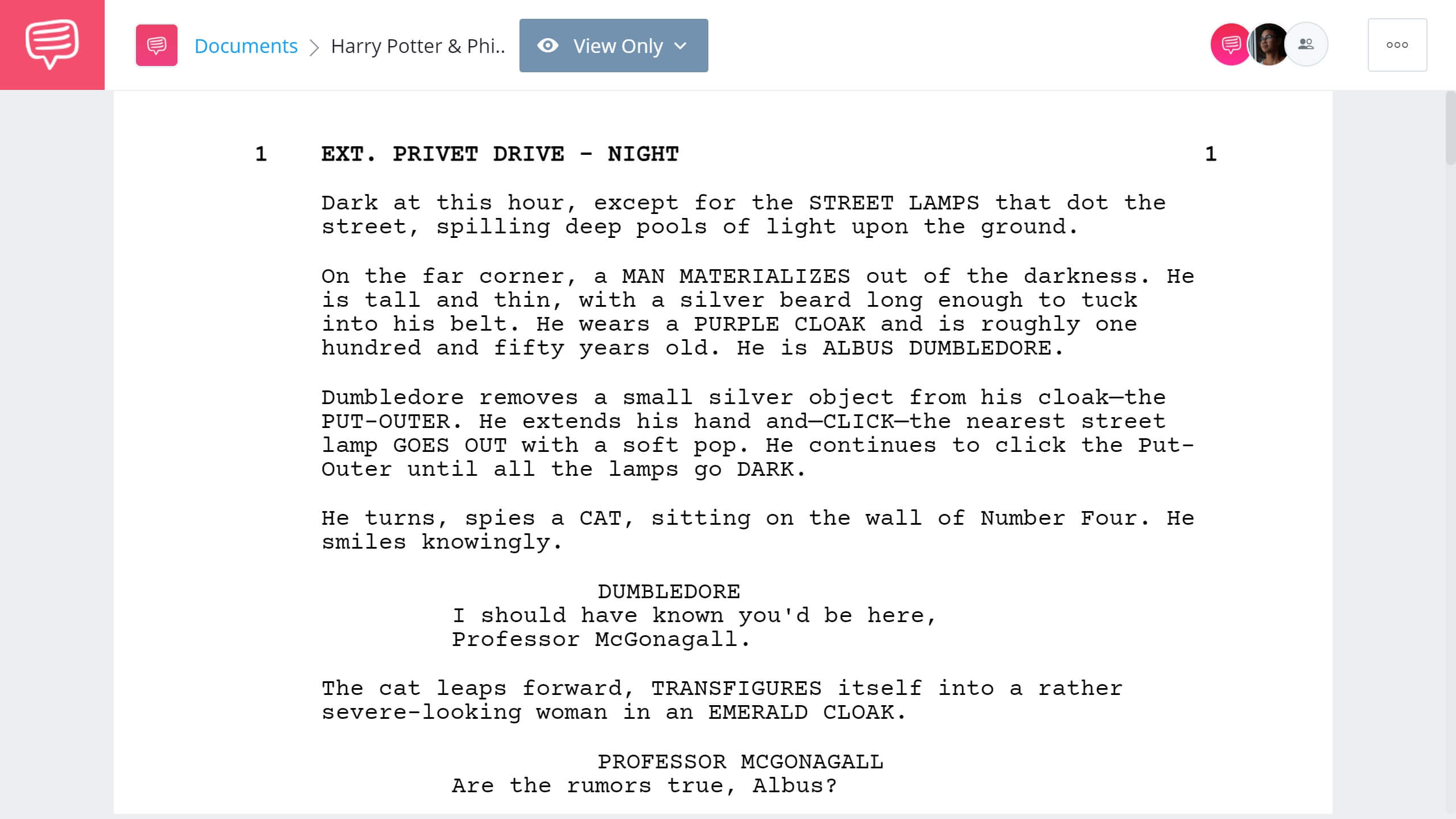
Read Full Harry Potter and the Sorcerer's Stone Script
Harry Potter and the Sorcerer’s Stone masterfully establishes the characteristics that Harry and Voldemort share, but it also establishes similarities between Dumbledore and Voldemort.
Throughout the series, these shared traits influence Dumbledore and Voldemort in their objectives and decisions.
For instance, in the Sorcerer’s Stone , we are introduced to how Voldemort and Dumbledore move through the world. Hagrid tells Harry early on about Voldemort’s rise to power: he was a wizard “who went as bad as you can go [...] anyone who stood up to him ended up dead.” Hagrid frames Voldemort as a powerful wizard, capable of massive destruction.
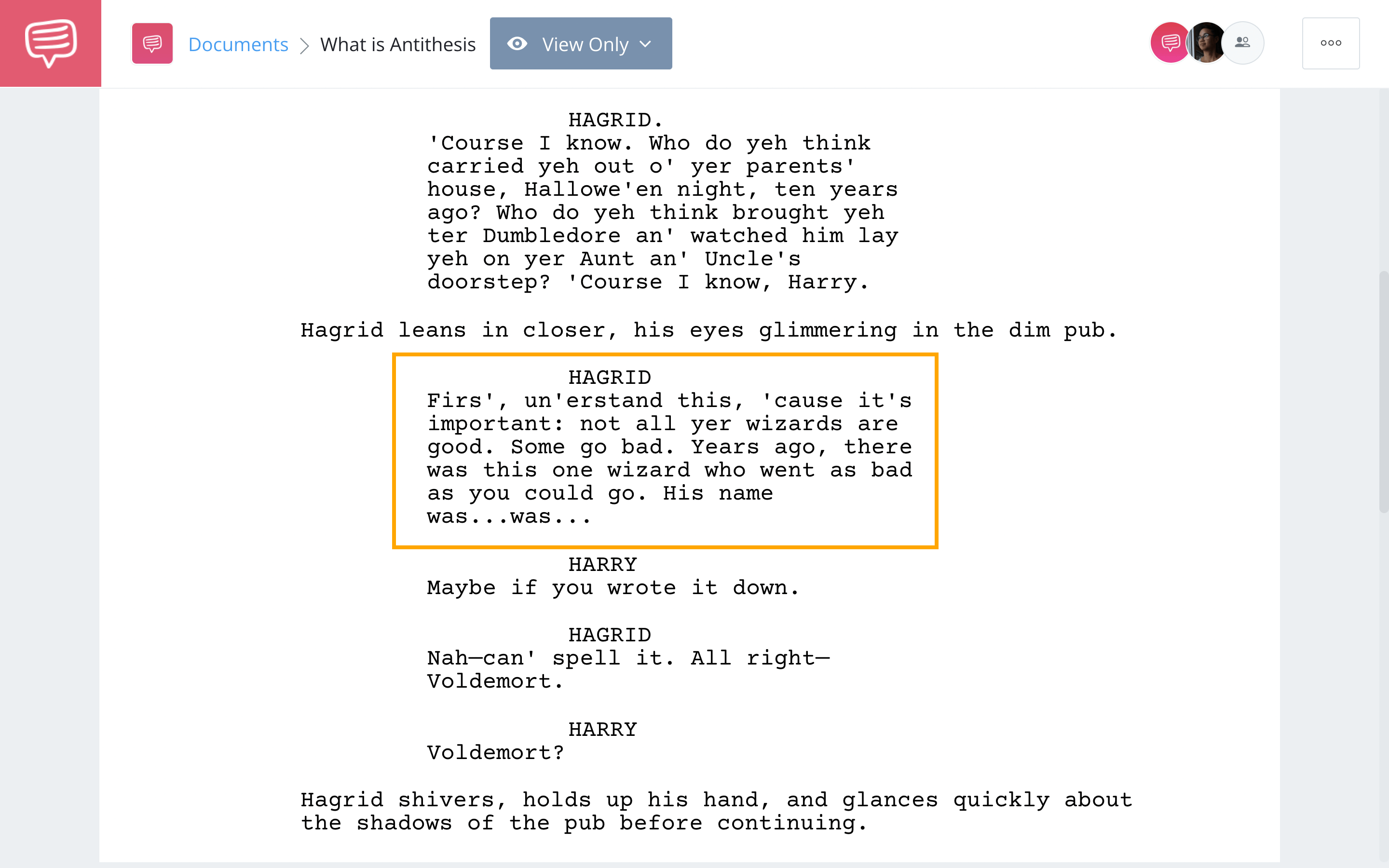
Antithesis Example in Harry Potter • Read Full Scene
Alternatively, towards the end of the first film Dumbledore explains his tactics in his work with Nicolas Flamel on the Sorcerer’s Stone . “Only a person who wanted to find the stone—find it, but not use it—would be able to get it.” Dumbledore respects power and the laws of magic, and his actions reflect that.
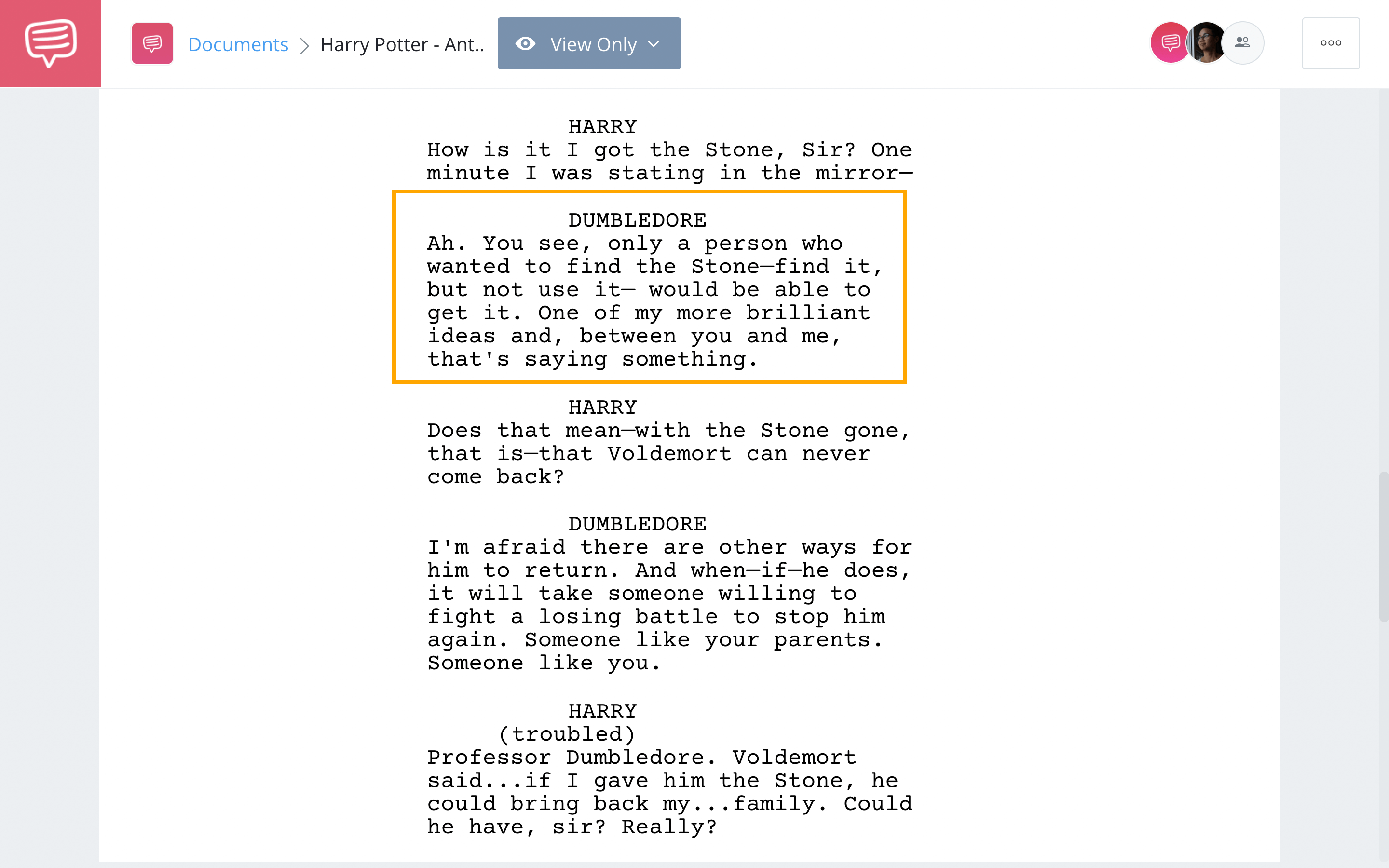
Further into the series, in Order of the Phoenix , we see what happens when Dumbledore’s tremendous abilities collide with Voldemort’s formidable power in their epic Ministry of Magic duel.
Voldemort’s spells all aim to destruct, whereas Dumbledore’s are equally amazing, but meant to disarm, distinguish, or defend.
The series is a remarkable example of how antitheses can be essential to a story, and the respective backstories, unique abilities, and of course choices of Voldemort and Dumbledore prove it.
Implementing Antitheses
How to use antithesis.
With all the ways you can implement and define antithesis, it’s good to have a number of tricks or rules of thumb to keep in your back pocket. Whether you’re writing a short story or your next feature screenplay, here are some things you can keep in mind.
1. Aim for Moderation
If you’re using antithesis in the form of a rhetorical device, try to keep the number of antitheses to a minimum unless it’s a crucial character trait of the speaker. Using a similar literary device too often can leave your writing predictable or even annoying. The more you use a tool, like antithetical language, the less meaning it can have.
2. Similar Structure
Keep the structure of your antithesis as similar as possible if you want to highlight the differences more intensely. And try to keep the phrasing itself balanced. Both variables of the equation don’t have to be exact, but the lyrical phrasing can help your antithesis shine and stick long after the read.
3. Focus on Differences
Focus on contrast but remember to find ways to draw the parallels. How can the characters be compared to the point where their differences become obvious? How can their differences lead to conversation about how the characters may actually be similar?
Antitheses via characters and sentence structure can assist in not just interesting writing, but memorable writing. They can make your message more understandable and retainable, which should be a top goal in any written work. You never want to give you reader a reason to stop reading.
So, now that you’ve learned more about how an antithesis can strengthen your work, you can implement it into your next project like a pro.
After all, no guts, no glory.
What is Irony?
Antithesis is a rhetorical device you can use in everyday speech. Much like an antithesis, we encounter several types of irony in everyday life, too. Keep reading to learn about the types of irony and how they’re used in TV and Film.
Up Next: Irony Explained →
Write and produce your scripts all in one place..
Write and collaborate on your scripts FREE . Create script breakdowns, sides, schedules, storyboards, call sheets and more.
Leave a comment
Your email address will not be published. Required fields are marked *
- Pricing & Plans
- Product Updates
- Featured On
- StudioBinder Partners
- Ultimate Guide to Call Sheets
- How to Break Down a Script (with FREE Script Breakdown Sheet)
- The Only Shot List Template You Need — with Free Download
- Managing Your Film Budget Cashflow & PO Log (Free Template)
- A Better Film Crew List Template Booking Sheet
- Best Storyboard Softwares (with free Storyboard Templates)
- Movie Magic Scheduling
- Gorilla Software
- Storyboard That
A visual medium requires visual methods. Master the art of visual storytelling with our FREE video series on directing and filmmaking techniques.
We’re in a golden age of TV writing and development. More and more people are flocking to the small screen to find daily entertainment. So how can you break put from the pack and get your idea onto the small screen? We’re here to help.
- Making It: From Pre-Production to Screen
- What is Method Acting — 3 Different Types Explained
- Ultimate Guide to Sound Recording: Audio Gear and Techniques
- How to Make a Production Call Sheet From Start to Finish
- What is Call Time in Production & Why It Matters
- How to Make a Call Sheet in StudioBinder — Step by Step
- 0 Pinterest

Antithesis Definition & Examples in Speech and Literature
Antithesis does not have to be a difficult thing to understand, despite its complicated name, it is a relatively simple form on English grammar which can be easily explained. We are going to take a look at what antithesis is and how it is to be used. We will look at various examples of antithesis in both written and spoken language to further assist us to understand it.
Antithesis Definition
Antithesis is, in fact, a word from ancient Greek that directly translates as ‘ opposite .’ When we talk about antithesis in the English language we are referring to a phrase that contains two contrasting ideas. Antithesis is used to express opposing ideas in a more vivid fashion in order that it has more of an impact on the person listening to or reading the language.
Antithesis in Figures of Speech
Antithesis used in figures of speech might sound something like the famous phrase made by Neil Armstrong on his moon landing, he said: “that’s one small step for man and one giant leap for mankind.” The small step and giant step are the antitheses because they are the direct opposite of one another and yet contrast in the sentence.
Antithesis in Rhetorical Devices
Antithesis in rhetoric, when two opposite statements are juxtaposed to create a contrasting notion, can be seen in the speech made by Martin Luther King, in the sentence “ I hope that one day my children will be judged not by their skin colour but by their character. ” When used in a rhetorical device , antithesis is designed to paint a picture of the concept.
Antithesis in Figurative Language
Antithesis can be used in figurative language , a good example of this is the phrase “ man proposes, God disposes. ” The two ideas are completely opposite to each other and yet when put in a sentence together create a contrasting idea.
Antithesis in a Literary Device
When used as a literary device , antithesis is designed to be used to sway the opinion of the reader or listener through the statement itself. An example of this comes once again from Martin Luther King when he said: “ we must learn to come together as brethren or perish together as fools. ” In this context, the antithesis is being used to point out the bad thing and highlight the good thing.
Antithesis Examples
Examples of antithesis in speech.
There will be many occasions when you are likely to hear antithesis during everyday conversations. We will now take a look at some examples of sentences in which antithesis is present.
- Give all men your ear, but few men your voice.
- Love is an ideal thing but marriage is a real thing.
- Speech is silver but silence is golden .
- Patience is bitter but it bears sweet fruit.
- Money is the root of all evil, poverty is the fruit of all goodness.
- She is easy on the eyes but hard on the heart.
- Everybody doesn’t like something but nobody doesn’t like this.
- Integrity without knowledge is frail and has no use and knowledge without integrity is risky and awful.
- People who have no vices also have not many virtues.
- Burning a fire to stay cool.
- Shutting a door in order to leave.
- Even though the sun shines, I can feel the rain.
- It is never too late but it is never too soon.
Examples of Antithesis in Literature
Many authors have used antithesis in their work in order to provide the reader with a thought-provoking, contrasting statement. We are now going to take a look at some examples of times when writers have used antithesis within poetry, fiction and other types of written work.
- A tale of two cities by Charles Dickens opens with the use of antithesis in the line “ Twas the very best in times, Twas the very worst in times. That was a time of wisdom and yet a time of foolishness. ” In this example, antithesis is used to imply the conflict of the time in which the story was set.
- “ To err is human, to forgive is divine, ” This is a line from the play Julius Caesar written by William Shakespeare. Here antithesis is used to refer to the fact that God the creator is forgiving yet he created a race of humans who were far from perfect.
- In the poem ‘community’ written by John Donne, we see the use of antithesis to compare love and hate. “ Good we must love and must hate ill. “
- Paradise lost written by John Milton features the use of antithesis when it compares the opposing ideas of heaven and hell alongside the opposing ideas of serving and reigning , in the sentence: “ It is better to reign in hell than to serve in heaven. “
- In the Holy Bible, we see the use of antithesis in the book of Matthew, where we can read the line “ many are called but few are chosen .”
- “ Give me a bit of sunshine, give me a bit of rain. ” This is an example of antithesis from the song Give me some sunshine by Swanand Kirkire. The notion of wanting sunshine is completely opposite to the idea of wanting rain and yet both are contained within the same sentence.
- In the song “My girl” by the band The Temptations we see antithesis being used in the line “ When it is cold outside, I have got the month of May .”
- “ In my beginning is my end .” This is an example of the use of antithesis within the poem Four Quartets which was written by T S Elliot.
- In the comic book featuring the character Green Lantern, an oath is written and the first line of this oath contains antithesis. “ In the brightest of days and in the blackest of nights .”
As we have seen, antithesis can be used in various ways in order to compare and contrast two opposing ideas. It can be used in a variety of ways depending on how it is being used, whether that be in the rhetorical, as a literary device or in a figure of speech.
Antithesis Infographic

- Latest Posts
- 10 Rare Words for Expanding Your English Vocabulary - June 5, 2024
- Hypocritical Meaning: What Does This Term Mean? - January 27, 2024
- SWAG Meaning: What Does it Mean? - January 25, 2024
What Is an Antithesis? Definition & 15+ Examples
Ever wondered how great writers and speakers create captivating contrasts to emphasize their points and leave you pondering?
The secret behind these mesmerizing moments often lies in the use of a powerful rhetorical tool called antithesis . This technique employs oppositional language to present contrasting ideas, which adds depth, color, and intrigue to language, leaving audiences eager for more.
From speeches to literature, antithesis has long been appreciated as a valuable component of persuasive and thought-provoking communication. Exploring these instances helps to deepen our understanding of how antithesis functions, as well as why it continues to be a beloved and effective rhetorical device in various forms of expression.
Let’s take a closer look:
Table of Contents
What Is Antithesis?
Antithesis is a figure of speech that uses parallelism to present opposing ideas. In essence, it is the juxtaposition of contrasting concepts, usually in balanced or parallel phrases, to create a heightened effect in a sentence or expression.
This rhetorical device can emphasize the differences between two opposing ideas, allowing the writer or speaker to deliver a powerful message more effectively.
In simple terms, “antithesis” is the opposition or contrast of ideas or words in a balanced construction. This technique is often employed to:
- Strengthen an argument.
- Emphasize a point.
- Create a vivid and memorable image for the reader or listener.
Antithesis can be found in various forms of literature, including poetry, prose, and speeches, and is often used to give emphasis to the importance of a particular idea or theme.
There are several ways in which antithesis can be presented:
- Word Antithesis: The use of opposing words or phrases, such as “love and hate” or “good and evil.”
- Ideological Antithesis: The expression of opposing beliefs or principles, such as “freedom versus tyranny” or “democracy versus totalitarianism.”
- Structural Antithesis: The arrangement of contrasting ideas in a parallel form, often using parallelism or repetition to highlight the contrast.
Employing antithesis can make language more expressive and engaging, drawing attention to the ideas being presented and making them more memorable. It serves as an effective tool for writers and speakers who seek to create a lasting impact on their audience through the power of opposing concepts.
Origins and History of Antithesis
Antithesis, derived from the Greek word “ antitithenai ,” which means “to set against,” is a figure of speech in which two opposing ideas are juxtaposed in a balanced, parallel manner. This deliberate contrast serves to heighten the impact of the ideas being presented and contributes to the overall strength and effectiveness of the argument.
Antithesis can be traced back to classical rhetoric , the art of effective and persuasive communication. It emerged prominently as a stylistic device in the works of ancient Greek and Roman orators and writers who sought to:
- Craft impactful arguments
- Create memorable phrases
The roots of antithesis lie in the use of parallelism , a rhetorical tool that involves expressing contrasting or opposing ideas in a balanced and parallel structure. This technique was employed by classical rhetoricians to emphasize the contrasts in their arguments and engage their audience effectively.
Throughout history, numerous famous orators and writers have demonstrated a mastery of antithesis. Here are some notable examples:
The ancient Greek philosopher was a skilled rhetorician, and his works often exemplified antithesis. In his work, Rhetoric , he provided a thorough analysis of various rhetorical techniques, including antithesis, to help his students persuasively convey their ideas.
As one of Rome’s greatest orators and a renowned lawyer, Cicero was well-versed in rhetorical devices. His speeches frequently utilized antithesis to emphasize particular points and create powerful statements that resonated with his audience.
William Shakespeare
The famous playwright often employed antithesis in his works, emphasizing contrasts and creating memorable lines. One of the most famous examples of antithesis in literature can be found in his play, Hamlet , with the line, “To be or not to be.”
Abraham Lincoln
The 16th President of the United States was also an adept user of antithesis. In his famous Gettysburg Address, Lincoln used antithesis to create a moving and poignant speech that resonates with audiences to this day.
These prominent figures from ancient Greece to modern times have utilized antithesis as an effective means of emphasizing contrasts and crafting impactful phrases, showcasing the enduring appeal of this rhetorical device.

Function and Purpose of Antithesis
It balances ideas, engages minds, and inspires reflection.
Antithesis serves several significant functions in both written and spoken language. Its primary purpose is to create balance , contrast , and emphasis , highlighting the differences between two opposing ideas or concepts.
By utilizing antithesis, writers, and speakers can effectively engage their readers or listeners and provoke thoughtful considerations of opposing viewpoints.
It Acts as a Catalyst for Deeper Understanding
The use of antithesis stimulates intellectual curiosity, prompting readers or listeners to ponder the implications of juxtaposing contrasting ideas.
This rhetorical device encourages deeper understanding and fuller appreciation of the complexities inherent in language and human thought. As a result, antithesis enhances the impact of a piece of writing or speech.
It Enhances Focus and Fosters Analytical Thinking
In addition, antithesis is an effective method for drawing attention to crucial points or ideas.
By bringing opposition to the forefront, it emphasizes the significance of contemplating various perspectives, which in turn fosters an open and analytical mindset. This technique is particularly beneficial in persuasive writing and speaking, as it can help sway the audience toward a specific stance or argument.
Examples of ways to employ antithesis include:
- Pairing opposite adjectives, such as “cold” and “hot,” to emphasize the extremity of the subject.
- Using contrasting phrases, like “sink or swim,” to underline the importance of a decision or action.
- Juxtaposing conflicting concepts or proposals, such as “peace” and “war,” to examine the consequences of each.
Types of Antithesis
Antithesis can be broadly divided into two categories: Verbal Antithesis and Conceptual Antithesis. Each type serves a different purpose in conveying opposing ideas or concepts in a piece of writing or speech.
Verbal Antithesis
Verbal Antithesis involves the use of words or phrases with opposite meanings in a single sentence or expression. This type of antithesis serves to emphasize the contrast between two opposing ideas by placing them in close proximity to one another.
Examples can include the use of:
- Oxymorons , where contradictory terms are combined.
- Parallelism , where contrasting words or phrases are structured similarly.
Some examples of Verbal Antithesis are:
- “It was the best of times, it was the worst of times.” (Charles Dickens)
- “To err is human, to forgive divine.” (Alexander Pope)
- “Give every man thy ear, but few thy voice.” (William Shakespeare)
Conceptual Antithesis
Conceptual Antithesis, on the other hand, does not rely on wordplay or linguistic contrasts. Instead, it focuses on presenting contrasting concepts or ideas in a larger context, such as within a narrative, argument, or theme.
This type of antithesis often involves juxtaposing characters, situations, or themes to highlight their differences and create tension or conflict. Examples can be found in various forms of literature and art, including:
- The opposing forces of good and evil in many religious texts.
- The conflicting moral perspectives in novels, such as in “To Kill a Mockingbird,” where Atticus Finch’s defense of Tom Robinson contrasts with the racism of the townspeople.
- The clashing beliefs and values in philosophical debates, like those between Socrates and the Sophists in ancient Greece.
Examples in Literature
Antithesis is a powerful literary device that writers have employed to create memorable works of poetry, prose, and drama. The use of antithesis not only heightens tension and deepens meaning within literature but it also heightens the reader’s experience and understanding.
Shakespeare
Known for his command of language, Shakespeare often employed antithesis in his plays and sonnets. One of the most famous examples is found in Hamlet’s soliloquy:
In this instance, the contrasting ideas of “ being ” and “not being” emphasize the central conflict of Hamlet’s character and the existential questions he grapples with throughout the play.
Charles Dickens
Antithesis can also be found in the opening lines of Charles Dickens’ celebrated novel, A Tale of Two Cities :
Dickens’ pairing of opposites establishes the novel’s social and political setting, which is characterized by paradoxical contrasts and deep divisions among the characters.
Jane Austen
Jane Austen’s Pride and Prejudice utilizes antithesis to highlight the differing perspectives of its main characters, Elizabeth Bennet and Mr. Darcy. Consider the following line:
This statement juxtaposes the idea of universal truth and personal desire, reflecting the novel’s themes of social expectations and individual choices.
Robert Frost
The celebrated poet Robert Frost deftly utilized antithesis in his work, such as in the poem Fire and Ice :
With the contrast between “ fire ” and “ ice ,” Frost explores the dual destructive forces of passion and indifference in human nature.
Examples in Speeches
Antithesis not only adds stylistic flair to speeches, but also enhances their rhetorical impact and persuasive effect. Below are examples from some famous speeches that demonstrate the use of antithesis.
Abraham Lincoln’s Gettysburg Address is considered one of the most powerful and well-crafted speeches in history. One effective example of antithesis in this speech is:
Lincoln contrasts words and actions, emphasizing the sacrificial deeds of the soldiers.
Winston Churchill
Winston Churchill’s speeches during World War II showcased his strong rhetorical skills. An example of antithesis in his famous Iron Curtain speech is:
Here, the physical location contrasts with the figurative iron curtain, underlining the division of eastern and western Europe.
Martin Luther King Jr.
In Martin Luther King Jr.’s I Have a Dream speech, he utilized antithesis to communicate his vision for a more inclusive and equal society. An example is:
King juxtaposes skin color and character, highlighting the content of one’s character as the more important factor for judgment.
John F. Kennedy
John F. Kennedy’s Inaugural Address also contains a well-known example of antithesis:
This statement reverses the expectations of the listener, placing emphasis on the civic responsibilities of citizens rather than government assistance.
Tips and Tricks: Mastering the Use of Antithesis
Mastering the use of antithesis can greatly enhance the effectiveness of writing and speech. In this section, we will discuss practical advice for incorporating antithesis effectively and ways to avoid common pitfalls.
Identifying Contrasting Ideas
Antithesis relies on the presentation of contrasting ideas to create emphasis and interest. To use this device effectively, one must first identify clear and meaningful contrasting ideas. Here are some suggestions:
- Consider the theme or topic of your writing or speech, and think about opposing viewpoints.
- Keep the contrasting ideas relevant to the central message.
- Identify contrasts in characterization, situation, or opinion.
Using Parallel Structures
Parallelism is a crucial aspect of using antithesis effectively. It serves to create balance and clarity in the presentation of contrasting ideas. To ensure parallelism:
- Identify the grammatical structure of the first half of the antithesis and maintain the same structure in the second half.
- Use similar syntax, word order, and punctuation to create a sense of symmetry.
- Maintain consistency in verb tense, voice, and mood throughout the antithesis.
Taking care to identify strong contrasting ideas and maintaining parallelism in the presentation of those ideas will ensure that antithesis is used effectively in writing and speech.
A Rich Tapestry: Related Terms and Concepts
In order to expand our understanding of antithesis, it is helpful to explore related rhetorical devices, such as oxymoron, paradox, and chiasmus. These terms may appear to be similar, but they each have distinct characteristics and functions within the realm of rhetoric and language:
An oxymoron occurs when two contradictory terms are placed side by side to form a new meaning. Examples of oxymorons include “deafening silence” and “bittersweet.”
A paradox is a statement or situation that seems to be contradictory but holds an element of truth. For instance, “less is more” and “I know that I know nothing” are paradoxical statements that reveal deeper truths.
Chiasmus involves the reversal of parallel grammatical structures, creating a crisscross pattern in a sentence or phrase. An example of chiasmus would be “Ask not what your country can do for you, but what you can do for your country.”
While these devices share the common trait of using contrast, their mechanisms and effects differ.
- In antithesis , opposing ideas are juxtaposed to emphasize the differences between them. For example, “To err is human; to forgive, divine.”
- Oxymoron is a condensed form of antithesis. It also focuses on contrast, but it conveys the opposing ideas through adjacent words rather than phrases or clauses.
- Paradox appears self-contradictory, but provides deeper insight upon closer examination. Unlike antithesis, which highlights the contrast between ideas, paradox seeks to reconcile the contradiction to reveal an underlying truth.
- Chiasmus creates a mirror-like structure in which elements are repeated in reverse order. While its primary function is to create balance and harmony, it can also be used to emphasize contrast, much like antithesis.
Case Studies: Analyzing the Use of Antithesis in Different Contexts
In this section, we will explore the use of antithesis in different fields including politics, advertising, and everyday conversation.
This rhetorical device is an effective means of creating a contrast to emphasize a particular point, and while it may be more commonly associated with literature and poetry, antithesis can be found throughout various forms of communication.
Politicians often use antithesis to draw attention to contrasting ideas and to emphasize their viewpoints.
For example, in his 1961 inaugural address, President John F. Kennedy employed antithesis when he urged Americans to:
By contrasting the individual’s responsibility toward their nation with the nation’s responsibility toward its citizens, Kennedy emphasized the significance of civic duty and personal responsibility in shaping the country’s future.
Advertising
In the world of advertising, antithesis is often used to create memorable slogans and to emphasize the unique selling points of a product or service. For example, a famous Mercedes-Benz tagline reads:
The contrasting phrases emphasize the idea that Mercedes-Benz automobiles stand out from the competition due to their engineering excellence. Such juxtaposition of opposing ideas helps reinforce the brand message and make it more memorable to potential consumers.
Everyday Conversation
Antithesis can also be found in our everyday conversations as it helps us emphasize contrasts, express humor, or simply make a point more clearly.
A common use of antithesis is in expressions like “ I t was the best of times, it was the worst of times,” taken from Charles Dickens’ A Tale of Two Cities . We also encounter antithesis when people use expressions like “You’re either with us, or against us,” highlighting the lack of middle ground in a situation.
These examples demonstrate how contrasting ideas, skillfully articulated through antithesis, can add depth and meaning to our daily interactions.
Understanding the Downside of Antithesis
While the use of antithesis can be an effective rhetorical strategy, it has certain drawbacks that are worth considering:
The Oversimplification Trap
One of the main concerns is the potential for oversimplification. When presenting two contrasting ideas, it can be easy to reduce complex issues into a simplistic binary choice, which may ignore important nuances.
Beware of False Dichotomies
Another downside is the risk of creating false dichotomies. In some cases, the use of antithesis may unintentionally reinforce the idea that only two opposing options exist, when in reality, alternative solutions or perspectives may be available. This can lead to limited critical thinking and hinder the exploration of other viewpoints.
Misrepresentation and Distortion
Additionally, the emphasis on opposition in antithesis can sometimes lead to a misrepresentation of the ideas being contrasted. The need to create a stark difference can encourage exaggeration or distortion of the original concepts, thereby weakening the overall argument.
Overuse: Striking a Balance
Lastly, overuse of antithesis can detract from the primary message of an argument or a text, by drawing attention away from the main points and focusing on the contrasts alone. As with any rhetorical device, moderation and careful consideration should be employed when using antithesis to communicate effectively.
Overuse and Misuse of Antithesis
While antithesis can be a powerful rhetorical device, it is essential to understand the potential pitfalls of overusing or misusing it in writing or speech.
- An overuse of antithesis may lead to the loss of its impact and may obscure the intended message.
- An misuse of antithesis can result in weak or illogical arguments.
Overuse Issues
One issue with the overuse of antithesis is that it can become repetitive and predictable. Similar to other rhetorical devices, antithesis works best when used sparingly and with purpose. Overusing antithesis can make the text monotonous and tedious to read, thus undermining the effectiveness of the arguments being presented.
Misuse Issues
When antithesis is misused, it can lead to the creation of false dichotomies or straw man arguments.
This occurs when a writer or speaker presents two opposing viewpoints in an attempt to create a strong contrast, but it ends up oversimplifying or misrepresenting the actual positions being debated. This weakens the overall argument and can make the writer or speaker seem less credible.
How to Avoid Them
To avoid overuse and misuse of antithesis, follow these guidelines:
- Use antithesis purposefully and strategically to emphasize a particular point.
- Be selective in the number of antitheses used in a piece of writing or speech to maintain effectiveness.
- Ensure that the contrasting ideas presented in the antithesis accurately represent the viewpoints being discussed.
- Avoid creating false dichotomies or straw man arguments by carefully examining the opposing ideas for nuances and common ground.
By adhering to these principles, writers, and speakers can utilize antithesis effectively, adding depth and impact to their arguments without sacrificing credibility.
Pros and Cons of Antithesis
Antithesis, a rhetorical device where opposing ideas are contrasted or balanced within a sentence or a phrase, is often employed to create emphasis and depth in writing. However, it has both advantages and disadvantages that writers should be aware of.
| Pros of Antithesis | Cons of Antithesis |
|---|---|
Pros of Antithesis:
- Emphasis on Key Points: Antithesis highlights the contrast between two opposing ideas or concepts, making it easier for the reader to focus on and understand the critical points.
- Stylistic Appeal: The use of antithesis adds an elegant and sophisticated touch to the writing, making it more engaging and thought-provoking for the reader.
- Memorability: By creating a distinct contrast, antithesis helps to make ideas or phrases more memorable, making the overall message of the text more likely to resonate with the audience.
Cons of Antithesis:
- Risk of Oversimplification: Antithesis can sometimes reduce complex ideas or issues to overly simplistic binaries, which may not fully represent the intricacies and nuances involved.
- Potential for Confusion: The contrast between opposing ideas may be difficult for some readers to comprehend, leading to potential misunderstandings or confusion.
- Overuse: Excessive use of antithesis in a piece of writing may make the text feel repetitive and heavy-handed, lessening the overall impact and effectiveness of the rhetorical device.
Writers can harness the strengths of antithesis by using it judiciously and avoiding overuse, ensuring that it adds value and depth to their work without compromising its integrity or clarity.
Frequently Asked Questions
Is antithesis effective in persuasion.
Yes, antithesis can be an effective persuasion tool. In political speeches and other forms of rhetoric, the use of antithesis is often employed to highlight the contrasts between opposing viewpoints or ideologies, making the argument or position more compelling.
Can antithesis be used in a simile or metaphor?
Antithesis can be incorporated into similes and metaphors to enhance their impact. While the purpose of a simile or metaphor is to make a comparison, using antithesis can further emphasize the primary differences between the compared elements.
Can antithesis be overused?
As with any literary device, antithesis can lose its effectiveness if overused. Employing antithesis sparingly and strategically ensures that its purpose is clear and that it contributes to the overall impact and meaning of the text.
Antithesis, as a rhetorical device, has been a powerful tool in language and literature. It is characterized by contrasting two opposing ideas or phrases, typically within parallel structures. This technique effectively highlights the differences and creates a balanced yet opposing relationship between ideas, drawing the attention of the reader or audience.
Examples of antithesis can be found in various forms of literature, including speeches, poetry, and prose.
| Famous Examples | Work |
|---|---|
| John F. Kennedy’s Inauguration Speech | |
| Shakespeare’s | |
| George Orwell’s |
These works serve as testimony to the enduring influence and significance of antithesis in shaping ideas and engaging readers.
Experimenting with antithesis in one’s own writing and communication can lead to a deeper understanding of texts and a more engaging style. By employing opposing ideas and parallel structures, writers and speakers can create memorable expressions, emphasize contrasting concepts, and provoke thought and discussion.
Whether used artfully in literature or strategically in rhetoric, antithesis remains an essential technique to master for effective communication. Embracing its potential can enhance the clarity and impact of ideas, leaving a lasting impression on readers and audiences alike.
How useful was this post?
Click on a star to rate it!
As you found this post useful...
Share it on social media!
We are sorry that this post was not useful for you!
Let us improve this post!
Tell us how we can improve this post?

Jessa Claire
What are you looking for?
Quick links.
Click here to find all our contact information
What is antithesis? A guide with examples
Find out how to use antithesis to improve your writing and see examples of antithesis being used in literature, poetry and advertising.

Introduction
This blog post is part of the Semantix copywriters’ toolkit, which is a great resource for writing professionals and all those looking to improve their writing, including language and marketing students. Firstly, we’ll discuss the definition of antithesis, including how it differs from similar rhetorical devices . Then, we’ll look at how other writers have used antithesis to set contrast and add impact to their work, including some famous examples of antithesis in literature, poetry and marketing.
What is antithesis?
The word antithesis is sometimes used to mean ‘opposite’. For example, “She is slim and sporty – the very antithesis of her brother”. However, ‘antithesis’ (or ‘antitheses’ if plural) is also the name given to a particular rhetorical or literary device. In this blog post, we’ll be looking at ‘antithesis’ in its role as the rhetorical and literary device.
The word ‘antithesis’ comes from the Greek for ‘setting opposite’. It means to express a concept by creating contrast. This can be done in different ways according to different definitions: either using only the content of the expression, or the content and the grammatical structure. Using the content can be as simple as using words with opposite meanings in close proximity to each other, or more complex by describing concepts that contrast with one another. This draws the reader’s attention to the differences between the two things.
Antithesis often presents opposing ideas and presents those ideas in a parallel grammatical structure. This is unlike general parallelism, which presents a balance of elements in a structure (sentence, clause or other) without necessarily involving the content. Antithesis is usually created in two parts, but can also be formed by three or more opposing clauses.
Writers can use antithesis to communicate a concept that is best expressed through opposites. It’s a simple yet effective way to really drive a point home. As with other literary devices , the rules aren’t set in stone, it’s more about using the device in ways that create impact and bring the words to life.
Examples of antithesis in literature
What makes a good piece of writing truly great? You might argue that the key ingredients include memorability, impact and the beauty of a rhythmical grammatical structure – deliverables that can be served skillfully with antitheses.
When you put two antithetical concepts together in a short phrase, you get drama. And drama is what keeps the reader turning the pages.
In addition, the parallel structure often used in antithesis makes the words stand out from the other text on a page. Working like a mental stop sign, it compels the reader to notice the contrasting ideas and consider the meaning of that contrast.
Using antithesis, writers can present contradictions by balancing opposing words and statements. This builds contrasting images in a reader’s mind and creates a powerful impression of either a character or circumstance.
A good portion of the best-known writers in history have been masters of antithesis. For example, antithesis plays a big part in the language used by William Shakespeare. In fact, nearly every character he created uses it. For example, in Mac beth the witches chant, “Fair is foul, and foul is fair” – a simple but dramatic antithesis. One of the best-known Shakespearean quotes of all time is an antithesis from the play Hamlet , when the prince says, “To be, or not to be...”. In just six words Shakespeare creates a perfect contrast between existing and not existing, inviting the audience to ponder the meaning of life itself.
Another famous use of antithesis is the expression, “To err is human; to forgive, divine”, which was written in 1711 by English poet Alexander Pope in ‘ An Essay on Criticism, Part II ’. After the original creation of the statement, further iterations have added the word ‘is’ so, “To err is human; to forgive is divine”, which, arguably, improves the rhythm by creating an equal number of words in each part of the sentence.
And it’s not just the writers of old who wield the sword of antithesis so well: their modern counterparts are equally aware of its power. For example, the Green Lantern comic writers use antithesis at the start of Green Lantern’s oath in order to emphasise his mission to defeat evil at all costs:
In brightest day , in blackest night , No evil shall escape my sight. Let those who worship evil’s might Beware my power – Green Lantern’s light!
Antithesis in poetry.
Poetry is perhaps the writing genre where we find the most graceful use of words. That’s why there are lots of antitheses used in poetry throughout history.
Take a look at the two-part structures and conceptual contrasts from some of the world’s best-known poems:
"Better to reign in Hell , then serve in Heav’n" – Paradise Lost , John Milton, 1667
“much madness is divinest sense ” – 620, emily dickinson, “some say the world will end in fire / some say in ice ” – fire and ice, robert frost, 1920.
Occasionally, a writer might even make use of a triple antithesis:
“Herein lives wisdom, beauty , and increase ; / Without this, folly, age , and cold decay ” – Sonnet 11, William Shakespeare, 1609
Antithesis in speeches.
Of course, what works on paper often works in its spoken form too. Some of the best speeches of all time can thank, at least in part, antithesis for their success.
“That’s one small step for a man – one giant leap for mankind” – Neil Armstrong, 1969
“we must learn to live together as brothers or perish together as fools ” – martin luther king jr, 1964, “on this day, we gather because we have chosen hope over fear, unity of purpose over conflict and discord ” – barack obama, 2009, antithesis in advertising.
Marketers love to make us remember how truly wonderful their services or products are. Antithesis provides marketers with a powerful tool: contrast to underline a unique selling proposition (USP) and a memorable rhythm. That’s why you’ll find the path to marketing gold is littered with antitheses: the antithesis is the life-blood of the tagline or slogan.
Take a look at how each of these taglines uses a parallel structure and creates opposition:
“ Small business. Big future” – Santander
“ heavy on features. light on price” – apple, “ tough on stains. gentle on skin” – persil, “ less calories; more taste” – so good, “inspired by yesterday , built for tomorrow ” – nokia, “ all of the taste. none of the sugars” – alpro, “ smart listens to the head. stupid listens to the heart” – diesel, antithesis, chiasmus and parallelism – what are the differences.
Parallelism, sometimes called parallel structure or parallel construction, is the repetition of grammatical structures in a piece of writing in order to create a balanced, harmonious effect.
Parallelism requires only the repeated grammatical structure, while antithesis uses the content – you can’t set up opposing concepts by only using the structure!
Look at this example, “They have plundered our seas, ravaged our coasts, burnt our towns – all while caring for their own oceans and cities.” The beginning of this statement repeats the same structure while changing the verbs and nouns. It doesn’t create a contrast between each clause or suggest any form of opposition. That’s the key difference between other forms of parallelism and antithesis: parallelism doesn’t need to present opposites, but antithesis is all about the opposites.
If a similar phrase was written using antitheses, it might read something like this. “They have plundered our seas; but have nurtured their seas. They ravaged our coasts; they cared for their own. They burnt our towns while they built their cities.” In the ‘antithesis version’, each clause is juxtaposed with another concept to create impact. You can hear how much more powerful the second phrase is if you read both versions out loud.
While antithesis is parallelism, not all parallelism is antithesis! For example, chiasmus is also a form of parallelism. In fact, it’s sometimes described as an inverted parallelism and happens when word order or grammatical structure is reversed in two phrases. For example, the phrase, “Do I love you because you are beautiful? Or are you beautiful because I love you?” qualifies as a parallelism and a chiasmus but there’s no opposition so it’s not an antithesis.
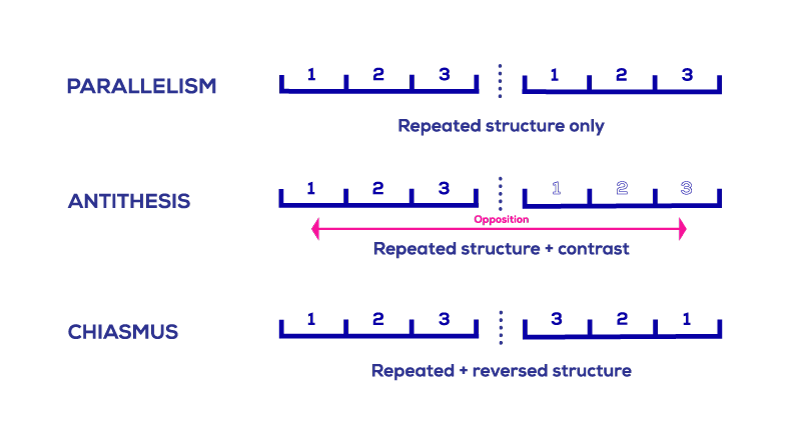
Semantix’s copywriting toolkit
Our copywriting toolkit is a valuable resource for anyone aiming to improve their writing skills. It contains definitions and examples of rhetorical devices in action, with guidelines on how and why they are used.
Using rhetorical devices, such as antitheses, is a time-proven method of taking your writing to another level and making sure that your words are impactful, memorable and effective. Whether you’re writing for pleasure or writing for business, they create drama and keep your readers or listeners engaged.
Semantix’s copywriting services
As the leading language solution provider in the Nordics, language is our passion. Every day, we help our clients reach new target audiences and enter new global marketplaces. We believe that language should be used as an opportunity to boost business and never be seen as a barrier.
Our copywriting services are available in more than 200 languages, and we only work with native-speaking translators . By matching you with a multilingual copywriter with experience in your specific industry, we’ll help you make every word work hard for your business in every language.
Want to find out more about our multilingual copywriting services?
Further reading.
- A Handlist Of Rhetorical Terms – Richard Lanham, University of California Press, 2013
- Simplified Glossary Of Literary Terms/Devices: An Easy-To-Use Source Of Definitions, Examples And Exercises For Students And Teachers – Victor Igiri, 2022
- The Oxford Dictionary Of Literary Terms (Oxford Quick Reference) 4th Edition – Chris Baldick, OUP Oxford, 2015
- The Elements Of Eloquence – Mark Forsyth, Icon Books, 2013
- The Elements Of Rhetoric – Ryan N S Topping, Angelico Press, 2016
- The Penguin Dictionary Of Literary Terms And Literary Theory – J A Cuddon, Penguin, 2014
- The Rhetorical Device: Literary Resources For The Writer Vol. 1 of 2 – Paul F Kisak, CreateSpace Independent Publishing Platform, 2016
- Writing With Clarity And Style: A Guide To Rhetorical Devices For Contemporary Writers – Robert A Harris, Routledge, 2017
- The Use Of Rhetorical Devices In Selected Speeches by Clinton & Trump: Discourse From The Electoral Campaign 2016 – Larissa Wolf, AV Akademikerverlag, 2018
- American rhetoric (online) Antithesis blog post
- Studiobinder (online) ‘What is antithesis’ blog post
- The Oxford Dictionary O f Literary Terms (Oxford Quick Reference) 4th Edition – Chris Baldick, OUP Oxford, 2015
- Voltaire, The Project Gutenberg EBook Of A Philosophical Dictionary, Volume 4 (of 10).
- Toastmasters (online) ‘The Crafting of Eloquence’ blog post .
Related content

A guide to the literary device anaphora – for professional wordsmiths

Literary devices list: examples of literary devices and how to use them

- How It Works
- In Center Learning
- Online Tutoring
- The Mathnasium Method
- How We Compare
- Homework Help
- Our Instructors
- Our History
- Overview of Programs
- Summer at Mathnasium
- Early Childhood
- Elementary School
- Middle School
- High School
- Own a Mathnasium

- Find Location
What Is Rotation in Math? Definition, Examples & How-to Guide

From describing the movement of the Earth in our solar system to simply turning a doorknob to enter our room, we use the term (and concept of) "rotation" frequently in our daily lives.
In math, we study rotation as one of the 4 geometric transformations.
We’ve prepared this middle-school-friendly guide for you to explore rotation as a geometric transformation using easy-to-follow definitions, simple guides, and solved examples.
What Is Rotation in Math?
Rotation in mathematics is a geometric transformation that turns a figure around a fixed point called the center of rotation .
Rotation is one of the 4 geometric transformations which also include:
- Translation : Sliding a figure without turning it
- Reflection : Flipping a figure over a line
- Dilation : Resizing a figure while keeping its shape
Examples of Rotation in Everyday Life
We are rotating at this very moment—literally! Our planet, Earth, rotates (or, as some say, spins ) around its own axis, completing the journey in 24 hours relative to the sun.
Yes, that is how we measure days!
One day equals the Earth’s one full rotation around its own axis.

Here’s an illustration of Earth’s rotation relative to the sun (P.S. Earth is actually much smaller than the sun than depicted in this picture.
Let’s explore more examples of rotation around us!
1. Car Wheels
Cars are propelled by rotation (among other things)!
Take steering wheels. A steering wheel is attached to the dashboard, its center fixed, while we rotate the frame around it to steer the car in a particular direction.
The wheels (the ones we attach tires to) are also an example of rotation. They too are attached at the center and rotate around it to propel the car forward or backward.

Car wheels and steering wheels included are a great example of rotation.
2. Spinning Top
Have you ever played with a spinning top or a dreidel?
The tip of the top remains fixed on the ground while the rest of it rotates around that point. This spinning motion demonstrates rotation around a fixed center.
3. Clock Hands
Most of us use our smartphones and smart watches to tell the time these days, but remember clocks?
You may still have one in your classroom.
Mechanical clocks are usually circular and feature 2 pointers, known as “hands,” in the middle. The shorter hand is called “minute hand” and longer pointer is called “hour hand” (dare to guess why?).
The center of the clock, where the hands attach, acts as the fixed point. As time passes, the hour and minute hands rotate around this center to indicate different times of the day.

Remember these?
4. Pirouette in Ballet
One of ballet’s signature moves, pirouette is based on the concept of rotation.
The dancer props themselves up on the tip of their toes on one leg and uses the other to propel themselves around this fixed point in a twirl , a motion also known as—you guessed it— rotation !
Key Terms in Rotation
To truly understand rotation in math, we need to know how to describe it.
Let’s go over some of the terms we use to talk about rotation.
1. Center of Rotation
The center of rotation is the fixed point around which a figure rotates.
It remains stationary while the rest of the figure moves around it.
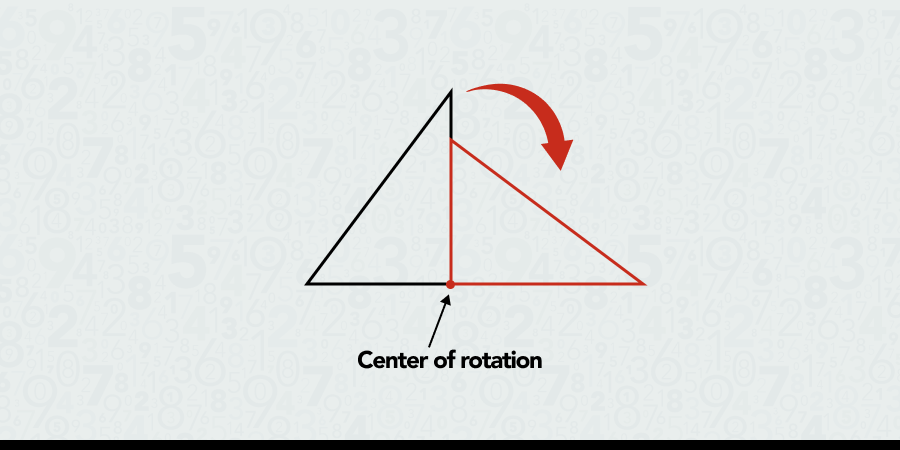
2. Angle of Rotation
The angle of rotation shows how much a figure is rotated around its center.
When students first learn how to rotate figures, the angle of rotation is measured in degrees (°).
The most common angles we use to illustrate rotations are:
- 90° : a quarter turn
- 180° : a half turn
- 270° : three-quarters of a turn
- 360° : a full rotation
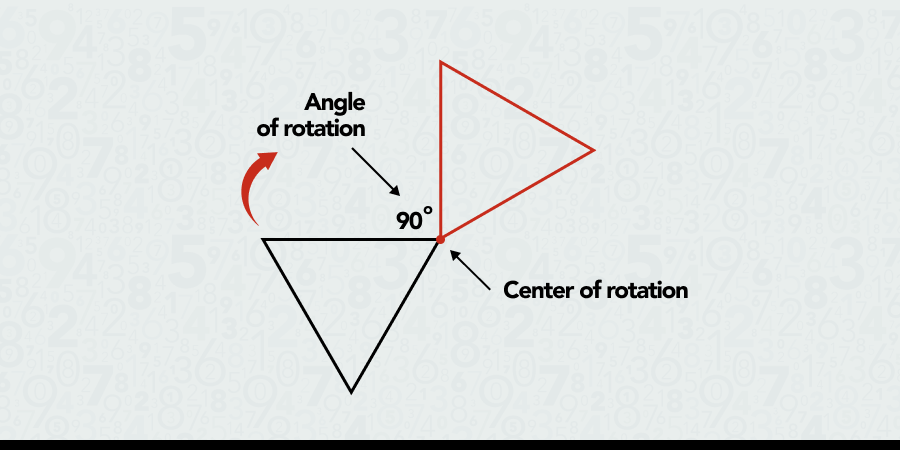
3. Direction of Rotation
The direction of rotation indicates the path a figure takes around its center.
Clockwise rotation moves in the direction of a clock's hands: to the right.
Counterclockwise rotation moves in the opposite direction: to the left.
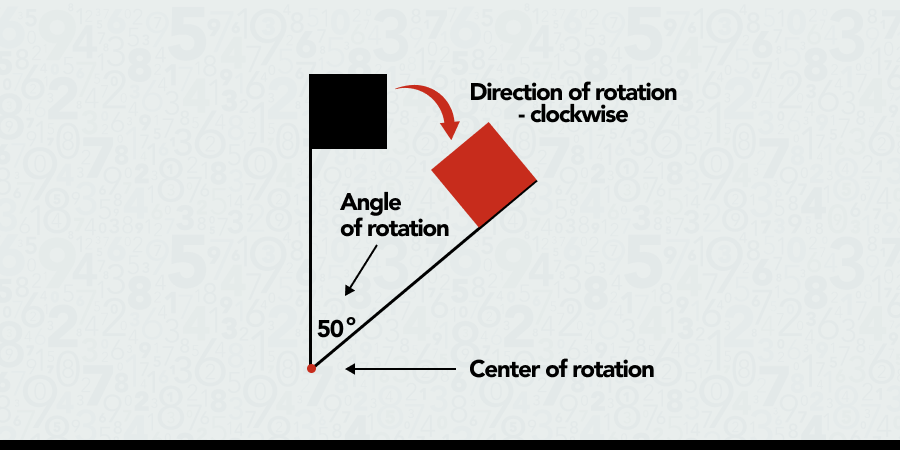
Rules of Rotation
The rules of rotation help us find the new position of a point after it has been rotated around the origin by a certain angle.
The types of rotation depend on the angle of rotation and the direction of rotation.
When learning about rotation in math, we usually use the coordinate plane to illustrate the process where one of the vertices of a figure is the center of rotation . The coordinate plane helps us track and visualize how figures move when rotated.
Let’s look at an example:
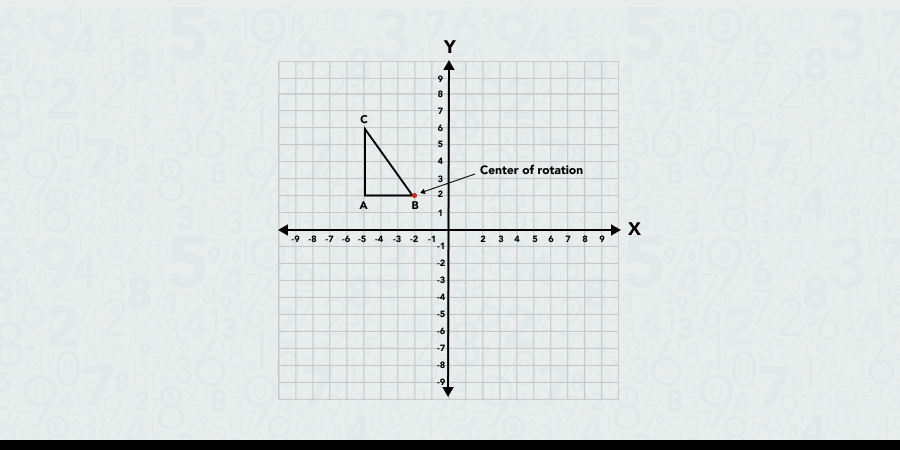
In this case, we will be rotating a triangle whose center of rotation is the vertex B.
To rotate the figure by 90° , we will turn it by a quarter-turn to the left (counterclockwise) or to the right (clockwise) around the fixed point B, a.k.a. our center of rotation.

When we rotate the figure by 180° , we will turn it by a half to left or right like so:

To rotate a figure 270° , we turn it by three-quarters around the fixed point to the left (counterclockwise) or to the right (clockwise).

A 360° rotation around one of the vertices would result in a full turn around the fixed point, returning the figure to its original position.
Now, let’s try a different center of rotation – one that is outside the figure we are rotating.
Another common method to do rotations on the coordinate plane is using the origin (0,0) as the center of rotation.

Notice how the x and y axis divide the coordinate plane into 4 quadrants.
When we rotate figures by 90° with the center at (0,0), we are moving the coordinates of our figure into the neighboring quadrant, either to the right or to the left.

When we rotate:
- Clockwise (to the right), (x, y) coordinates become (y, -x)
- Counterclockwise (to the left), (x, y) coordinates become (-y, x)
When we rotate a figure by 180 degrees on the coordinate plane, we are moving it to the quadrant directly opposite its original position. For instance, if we want to rotate a figure in Quadrant I by 180 degrees, we will end up moving it to Quadrant III.

After a 180° rotation, our (x, y) coordinates simply become negative (-x, -y).
For a 270° rotation around the origin, the figure moves on to the opposite side of the coordinate plane, three quadrants away from its starting position.

- Clockwise (to the right), (x, y) coordinates become (-y, x)
- Counterclockwise (to the left), (x, y) coordinates become (y, -x)
Here’s a quick overview of what happens to our coordinates when we rotate figures at angles 90°, 180°, and 270° clockwise (CW) or counterclockwise (CCW) on a coordinate plane:
|
|
|
|
|
| (x, y) | (y, -x) |
|
| (x, y) | (-y, x) |
|
| (x, y) | (-x, -y) |
|
| (x, y) | (-y, x) |
|
| (x, y) | (y, -x) |
How to Rotate Figures on the Coordinate Plane
Now that we know the language and basic concepts in rotation, let’s see how we rotate figures on the coordinate plane.
We can start with an example where a vertex of the figure is the center of rotation.

Our steps are:
- Draw the original figure on the coordinate plane. In our case, it will be a rectangle.
- Label the vertices (A, B, C, and D) and select one vertex of the rectangle – say vertex A – as the center of rotation.
- Determine the angle of rotation. For example, let’s rotate the figure 90° counterclockwise (to the left).
- Visualize the rotation. Imagine the figure spinning around vertex A like a clock hand moving backward. This can help you understand how each point will move.
- Draw the rotated rectangle by moving points B, C, and D 90° around vertex A while it remains fixed.
- Compare the new positions of vertices B, C, and D (now labeled B', C', and D') with their original positions to ensure correct rotation.

Now, let's rotate the triangle ABC, represented on the coordinate plane below, 90° clockwise (to the right) around the origin (0,0).

First, let’s write down our coordinates:
If we are rotating our triangle 90° clockwise, our coordinates will change like so:
Let’s apply the rule to calculate the new coordinates:
- A' = (2, – (– 5)) = (2, 5)
- B' = (5, – (– 5)) = (5,5)
- C' = (2 – (– 1)) = (2, 1)
We can now rotate the position of triangle ABC on the coordinate plane using our new coordinates.

Solved Examples of Rotation
Now that we know how to apply the rules of rotation to rotate figures on the coordinate plane, let’s practice rotation using different shapes, angles, and directions.
Let’s rotate the triangle ABC by 180° clockwise around the origin.

The coordinates of our triangle are:
Since we’re rotating the triangle 180°, half a turn around the origin (0,0), our values will become negative: (x, y) —> (– x, – y)
Using this logic, the coordinates of our rotated image will be:
- A' = ( – 2, – 2)
- B' = ( – 8, –8)
- C' = ( –5, – 7)
With the new coordinates, we can produce the image on the coordinate plane.

Let’s rotate the rhombus ABCD 270° counterclockwise around the origin.

The coordinates of the rhombus ABCD are:
A (3,7), B (1,4), C (3,1), D (4,4)
For rotation of 270° counterclockwise, we use the rule:
You might have noticed that this is the same formula we use for rotation of 90° clockwise.
Now, we calculate the new coordinates:
- A' = (7, –3)
- B' = (4, –1)
- C' = (1, –3)
- D' = (4, –4)
We have everything we need to produce the image on the coordinate plane.

Finally, let’s rotate the hexagon ABCDEF 270° clockwise.

The coordinates of the hexagon ABCDEF are:
For rotation of 270° clockwise, we use the rule: (x, y) = (–y, x)
Let’s calculate the new coordinates:
- A' = ( –7, 2)
- B' = ( –5, 1)
- C' = ( –3, 2)
- D' = ( –3, 4)
- E' = ( –5, 5)
- F' = ( –7, 4)
Our next step is to produce the image on the coordinate plane

Frequently Asked Questions About Rotation in Math
Here are some common questions about rotation that students often ask us.
1) What happens to a figure if you rotate it by 360 degrees?
Rotating a figure by 360 degrees around the origin brings the figure back to its original position, so the coordinates of each point in the figure remain the same.
2) Can rotations change the size or shape of a figure?
No, rotations can’t change the size or shape of a figure. They preserve the size, shape, and orientation of the figure.
3) Can I rotate a figure by any angle?
Yes, you can rotate a figure by any angle. Common angles like 90°, 180°, and 270° have simple formulas, but other angles can also be used with trigonometric calculations.
4) Are there any shapes you can’t rotate?
No. You can rotate any shape on the coordinate plane, including polygons, circles, and irregular shapes.
Learn and Master Rotations with a Top-Rated Geometry Tutor Near You
Mathnasium’s specially trained math tutors work with K-12 students of all skill levels to help them understand and excel in any math class and topic, including rotation.
Explore our approach to middle school math tutoring :
- 6 th grade math tutoring
- 7 th grade math tutoring
- 8 th grade math tutoring
Our tutors assess each student’s current skills and considers their unique academic goals to create personalized learning plans that will put them on the best path towards math mastery.
Whether you are looking to catch up, keep up, or get ahead in your math class, find a Mathnasium Learning Center near you, schedule an assessment, and enroll today!
Find a Math Tutor Near You
SEE HOW MATHNASIUM WORKS FOR YOUR SITUATION
Answer a few questions to see how it works, my child is:.

- Advanced in Math

- Doing Ok, Could Do Better

- Struggling with Math

OUR METHOD WORKS
Mathnasium meets your child where they are and helps them with the customized program they need, for any level of mathematics.

Related Articles
What is translation in math definition, examples & how-to guide.
Learn and master translation in math with our middle-school friendly guide featuring clear definitions, solved examples, and practice materials.
What Is Volume in Math? A Kid-Friendly Guide
Read on to find simple definitions and explanations, learn to calculate volumes of 3D objects, see solved examples, and test your knowledge with bonus practice exercises.
Olympics-Inspired Activities for The Whole Family
4 ways to challenge kids both physically and mentally.
HELP YOUR CHILD ACHIEVE THEIR FULL MATH POTENTIAL
We have nearly 1,000 neighborhood centers nationwide. get started now..
- Find a location
- Get a math skills assessment for your child
- Your child will complete a customized learning plan
- Expand beyond
- Apply math in fun creative ways that they’ll never forget
- Mathnasium Method
- International Locations
- Our Results
- About Mathnasium
- Own a Franchise
- Math Tutors Near Me
- Accessibility
- Privacy Policy
- Cookie Settings
- Terms of Use

- Share full article
Advertisement
Supported by
Styles Group Chat
Just How Demure Are You?
A TikTok trend has breathed new life into a fusty word.

By The Styles Desk
If you opened TikTok this week and felt that suddenly everyone was using the word “demure” out of nowhere, you’re not alone.
Your morning coffee with just a little half-and-half? Demure. The way you sit down gracefully on the subway? Very demure. The way you floss your teeth after lunch in the office bathroom before returning to your cubicle? Absolutely, totally demure.
Seemingly overnight, an adjective usually reserved for a reserved woman has become the semi-ironic word du jour on social media.
On Aug. 2, a TikTok creator who goes by the name Jools Lebron posted a video with tips about managing makeup and mustache sweat and being demure.
Later that day, she posted another video , which has been viewed four million times, offering tips on how to be demure at work. “Very demure, very mindful," she says, explaining her perfume, clothing and hairstyle choices for the workplace. Ms. Lebron has since posted dozens more such videos discussing how to be demure in all sorts of situations, like nail salons, hotels and drag shows.
Ms. Lebron, who did not respond to requests for comment, is one of several trans creators on TikTok whose playful use of “demure” in recent videos has helped the word catch on with other users.
We are having trouble retrieving the article content.
Please enable JavaScript in your browser settings.
Thank you for your patience while we verify access. If you are in Reader mode please exit and log into your Times account, or subscribe for all of The Times.
Thank you for your patience while we verify access.
Already a subscriber? Log in .
Want all of The Times? Subscribe .
| You might be using an unsupported or outdated browser. To get the best possible experience please use the latest version of Chrome, Firefox, Safari, or Microsoft Edge to view this website. |
What Is A Single-Member LLC? Definition, Pros And Cons

Published: Aug 13, 2024, 8:20am

Table of Contents
Single-member llc defined, single-member llc vs. sole proprietorship, how to form a single-member llc, pros and cons of a single-member llc, bottom line, frequently asked questions (faqs).
There are many types of limited liability companies (LLCs), each with a range of benefits and specific requirements. One of the most common types of LLC is a single-member LLC, which is a limited liability company with only one owner. Incorporating a single-member LLC may or may not be right for your specific situation. In this article, we discuss the ins and outs of single-member LLCs, including the pros and cons and how to set one up.
An LLC is a type of legal business structure that limits the liability of its owners from the debts and obligations of the business. It also provides pass-through taxation, where business profits and losses “pass through” to the owners’ personal tax returns. The most common type of LLC is a single-member LLC, which offers all the same advantages and disadvantages of a standard LLC but only has one owner.
Single-member LLCs are considered a “disregarded entity” by the IRS, meaning that for tax purposes, they are not treated separately from the owner. The existence of the LLC is essentially ignored for tax purposes. All business profits and losses are reported on the single owner’s year-end tax returns. Owners of single-member LLCs are also subject to self-employment tax, which includes the portion of Medicare and Social Security taxes usually covered by an employer.
The primary benefit is that single-member LLCs protect their owner’s personal assets from business debts and other liabilities.
Featured Partners
ZenBusiness
$0 + State Fees
Varies By State & Package

On ZenBusiness' Website

On LegalZoom's Website
Northwest Registered Agent
$39 + State Fees

On Northwest Registered Agent's Website
$0 + State Fee
On Formations' Website
Single-member LLCs and sole proprietorships have many commonalities and a few crucial differences. A sole proprietorship is the simplest form of single-member business and doesn’t require any registration or paperwork unless you give the business a name other than your own. In that situation, you have to file a doing business as (DBA) form with your city or county. Any solo business entity that has not legally formed an LLC or corporation is classified automatically as a sole proprietorship.
Like single-member LLCs, sole proprietorships are considered pass-through entities and all profits or losses are reported on the owner’s tax returns. Sole proprietorships are also subject to the same self-employment tax that LLCs are required to pay. However, unlike single-member LLCs, a sole proprietorship is not legally considered separate from its owner and does not offer limited liability.
This means that the business owner is ultimately responsible for the sole proprietorship’s debts and obligations. Tracking business and personal expenses can also be trickier as a sole proprietor, since there’s no requirement to open a separate business banking account. A single-member LLC requires a business account, which can make it easier for the business owner to track expenses properly.
Single-member LLCs are formed within the state in which they operate. Registration can be done manually or through an LLC service , such as LegalZoom, which makes the process much easier but costs more than doing it yourself. Specific formation requirements vary slightly by state, but the typical steps to form a single-member LLC are as follows:
- Select a business name : The first step is to choose a business name and verify that it’s available in your state. Typically, each state has its own online LLC name search.
- Choose a registered agent : A registered agent is a business or person who receives legal documents on your business’s behalf. All states require that single-member LLCs operate with a registered agent. Services, such as LegalZoom or ZenBusiness, can act as a registered agent on your behalf.
- File your articles of organization : This is your certificate of formation that contains basic business details about your LLC. Articles of organization typically are filed with the secretary of state’s office within the state you’re registering. You can file online, by mail or in person.
- Create an operating agreement : An operating agreement is a legal document that outlines the ownership structure, management and operational procedures of the LLC. These agreements may be mandatory in the state where you are registering your LLC. Several online platforms, such as LegalZoom, offer operating agreement templates that you can use to create your own.
- Get an employer identification number (EIN) : Once your single-member LLC is formed, you’ll need to register for an EIN—also known as a federal tax ID number. This is essentially a Social Security number for your business and can be acquired directly from the IRS.
- Obtain any necessary licenses : Some types of businesses may be required to apply for industry-specific permits or business licenses, such as contractors or health professionals.
As you can see, even though single-member LLCs offer many benefits, they also have additional requirements when compared to a sole proprietorship. Let’s look at the pros and cons of forming a single-member LLC.
Single-member LLCs provide many advantages but don’t come without drawbacks. Here are the top pros and cons of a single-member LLC business structure.
Single-Member LLC Pros
- Limited liability : Single-member LLCs protect their business owners’ personal assets from the debts and obligations of the business.
- Pass-through taxation : The profits of a single-member LLC pass through to the business owner’s personal tax returns, avoiding the double taxation that can occur with a corporation.
- Management flexibility : Owners of a single-member LLC can choose to manage the LLC themselves or hire employees to manage it for them.
- Business credibility : Single-member LLCs can provide more business credibility to customers and investors compared to sole proprietorships, which are not considered legal entities.
Single-Member LLC Cons
- Formation and compliance costs : Single-member LLCs are subject to more compliance requirements (operating agreements, annual reports, etc.) and cost more than a sole proprietorship due to filing fees.
- Self-employment taxes : Single-member LLCs are subject to self-employment tax, which represents both the employee and employer portion of Medicare and Social Security taxes. Forming your business as an S-corp instead can reduce self-employment taxes.
- Lack of funding options : Single-member LLCs may find it harder to raise funding when compared to a traditional corporation since it cannot issue stock.
Single-member LLCs are LLCs with only one owner. There are many benefits of a single-member LLC, the greatest being protection against the debts and liabilities of the business. However, single-member LLCs have additional filing requirements and fees when compared to a sole proprietorship. For this reason, it’s important to fully understand the pros and cons of a single-member LLC before forming one.
Can spouses be considered single-member LLCs?
Married couples who wholly own an LLC can be considered one member and can elect to be treated as a single-member LLC in states with community property laws. However, this may differ based on your state and it’s important to verify first before proceeding.
What’s the difference between a single- and a two-member LLC?
A single-member LLC is owned by a single person and all profits and losses pass through to their tax returns. Meanwhile, a two-member LLC is owned by two people and all profits and losses are passed through to the two owners based on their ownership percentages.
Why should I create a single-member LLC?
All businesses that are owned by a single person should consider creating a single-member LLC. This is because single-member LLCs offer additional liability protection and other benefits when compared to a sole proprietorship.
- Best LLC Services
- Best Registered Agent Services
- Best Trademark Registration Services
- Top LegalZoom Competitors
- Best Business Loans
- Best Business Plan Software
- ZenBusiness Review
- LegalZoom LLC Review
- Northwest Registered Agent Review
- Rocket Lawyer Review
- Inc. Authority Review
- Rocket Lawyer vs. LegalZoom
- Bizee Review (Formerly Incfile)
- Swyft Filings Review
- Harbor Compliance Review
- Sole Proprietorship vs. LLC
- LLC vs. Corporation
- LLC vs. S Corp
- LLP vs. LLC
- DBA vs. LLC
- LegalZoom vs. Incfile
- LegalZoom vs. ZenBusiness
- LegalZoom vs. Rocket Lawyer
- ZenBusiness vs. Incfile
- How To Start A Business
- How to Set Up an LLC
- How to Get a Business License
- LLC Operating Agreement Template
- 501(c)(3) Application Guide
- What is a Business License?
- What is an LLC?
- What is an S Corp?
- What is a C Corp?
- What is a DBA?
- What is a Sole Proprietorship?
- What is a Registered Agent?
- How to Dissolve an LLC
- How to File a DBA
- What Are Articles Of Incorporation?
- Types Of Business Ownership
Next Up In Company Formation
- Best Online Legal Services
- How To Write A Business Plan
- Member-Managed LLC Vs. Manager-Managed LLC
- Starting An S-Corp
- LLC Vs. C Corp
- How Much Does It Cost To Start An LLC?

What Is SNMP? Simple Network Management Protocol Explained
What Is Penetration Testing? Definition & Best Practices
What Is Network Access Control (NAC)?
What Is Network Segmentation?

How To Start A Business In Louisiana (2024 Guide)
How To Start A Business In Pennsylvania (2024 Guide)
Evan is a writer and entrepreneur with a background in technology and content marketing. He is currently the Head of Growth at Sagetap.io. Previous to Sagetap, he was was co-founder & CEO of the online publication Selling Signals, which was acquired in 2022, and served as General Manager for the online publication Fit Small Business.
Rachel Williams has been an editor for nearly two decades. She has spent the last five years working on small business content to help entrepreneurs start and grow their businesses. She’s well-versed in the intricacies of LLC formation, business taxes, business loans, registered agents, business licenses and more.
Urinalysis (urine test)
A urinalysis is a simple test that looks at a small sample of your urine. It can help find problems that need treatment, including infections or kidney problems. It can also help find serious diseases in the early stages, like kidney disease , diabetes , or liver disease. A urinalysis is also called a “urine test.”
A urine test can include three parts:
- Visual exam. The urine will be looked at for color and clearness. Blood may make urine look red or the color of tea or cola. An infection may make urine look cloudy. Foamy urine can be a sign of kidney problems.
- Microscopic exam. A small amount of urine will be looked at under a microscope to check for things that do not belong in normal urine that cannot be seen with the naked eye, including red blood cells, white blood cells (or pus cells), bacteria (germs), or crystals (which are formed from chemicals in the urine and may eventually get bigger and become kidney stones).
- Acidity (pH) is a measure of the amount of acid in the urine. A pH that is above normal may be a sign of kidney stones, urinary infections, kidney problems, or other disorders.
- Protein is an important building block in the body. Everyone has protein in their blood. But it should only be in your blood, not your urine. Your kidneys play a role in this process. Healthy kidneys remove waste products and extra water from your blood, but leave behind the things your body needs, like protein. When kidneys are injured, protein leaks into your urine. Having protein in your urine suggests that your kidney's filtering units are damaged by kidney disease.
- Glucose (sugar) is usually a sign of diabetes.
- White blood cells (pus cells) are signs of infection.
- Bilirubin is a waste product from the breakdown of old red blood cells. It is normally removed from the blood by the liver. Its presence in the urine may be a sign of liver disease.
- Blood can It can be a sign of an infection, a kidney problem, certain medicines, or even heavy exercise. Finding blood in the urine requires further testing. It does not mean you have a serious medical problem.
A urinalysis can help to detect many diseases before you feel symptoms. Finding and treating a problem early can help keep serious diseases from getting worse.
For More Information
Urinalysis and Kidney Disease: What You Need to Know
How helpful was this content?
Related kidney topics, estimated glomerular filtration rate (egfr), contrast dye and the kidneys, know your kidney numbers: two simple tests, can my gfr get better, urine albumin-creatinine ratio (uacr), related news and stories.

March 15, 2023
Pushing for Kidney Disease Screenings to Help the Patients that Need Them Most

January 13, 2023
Early Diagnosis of Kidney Disease: Incentivizing Comprehensive Testing

December 20, 2022
5 People with Kidney Disease Share Their COVID-19 Experiences

November 22, 2022
Flu Season is Back. How People with Kidney Disease Can Prepare

October 27, 2022
What Your Urine Says About Your Kidney Health

October 04, 2022
What the New eGFR Calculation Means for Your Kidney Disease Diagnosis and Treatment
We earn a commission for products purchased through some links in this article.

The Duchess of Sussex is the definition of easy elegance in all-white outfit
A classic case of one-tone dressing
Following a visit to a local drum school in Cartagena, Meghan and Prince Harry ventured to the historic village — referred to as Palenque by locals — which became the first free African town in the Americas when it was established in 1619.

Meghan has been showcasing some event-appropriate smart-casual styling throughout the duration of the trip, going from a colourful dress by the Colombian designer Johanna Ortiz to a low-key blazer and jeans combo. Day three continued to set the bar high, with the duchess swapping the summery camisole set that she wore earlier in the day for a sophisticated all-white look.
In a classic case of one-tone dressing – a fool-proof way of looking polished and put-together – Meghan tucked a sleeveless knitted tank top from Argen t into a white linen skirt from Posse . For a final touch, she added a white wide-brim sunhat with a black ribbon, from the Colombia-based brand Hannia Char. Finally, she completed the look with black sandals from Emme Parsons, a bag from Cesta, and an array of jewellery that included pearl drop earrings and her signature Cartier accessories .

Meanwhile, Harry also executed an outfit change. The prince stepped out in a light blue linen shirt with the sleeves casually rolled up to his elbows and a pair of white Loro Piana trousers.
During their tour of Palenque, the Sussexes met with community members (greeting them with, “Hola! Azina-po-tabde” – a mixture of Spanish and the town’s indigenous language of Palenquero), explored a street market, and attended a local concert. Meghan said she was “so honoured” to receive an invitation to the town in order to witness its “incredible history,” while Harry said the tour was an “incredibly moving experience.”

The nation's vice president, Francia Márquez, also delivered a speech on the significance of Palenquen culture and history. “I wanted them to come here and discover the essence of who we are — our spirituality, our music, our culture and our ancestral heritage that is still very much alive today,” Márquez said. “In the midst of adversity this is what has helped us continue to be resilient. Palenque is in the heart of every Afro-Colombian.”
Meghan and Harry arrived in Colombia earlier this week at Márquez’s invitation . The four-day trip — which marks their first official joint visit to Colombia — has thus far taken them through the cities of Bogotá and Cartagena, ending with a stop in Cali .
This visit is the duke and duchess’ third international trip of the year, following previous excursions to Canada in February and Nigeria in May.
Harper’s Bazaar is on the ground with the Sussexes as they embark on their four-day visit to Colombia. Check back for more.
Royal Family

Meghan and Harry's Colombia tour: in pictures

Meghan is in her "chapter of joy"

Meghan wears elegant navy set to land in Colombia

Kate congratulates Team GB in Olympics video

King Charles opens new tourist attraction

Prince William launches a new documentary series

Harry and Meghan confirm Colombia tour visit

Harry and Meghan on protecting Archie and Lilibet

Prince Harry confirms Invictus Games UK return

New picture of Prince George released for birthday

Kate praises the healing power of nature

IMAGES
COMMENTS
Proverbs are simple and often traditional sayings that express insight into truths that are perceived, based on common sense or experience. These sayings are typically intended to be metaphorical and therefore rely on figures of speech such as antithesis. Proverbs that utilize antithetical parallelism feature an antithesis to bring together opposing ideas in defined contrast.
Here's a quick and simple definition: Antithesis is a figure of speech that juxtaposes two contrasting or opposing ideas, usually within parallel grammatical structures. For instance, Neil Armstrong used antithesis when he stepped onto the surface of the moon in 1969 and said, "That's one small step for a man, one giant leap for mankind ...
antithesis: [noun] the direct opposite. the rhetorical contrast of ideas by means of parallel arrangements of words, clauses, or sentences (as in "action, not words" or "they promised freedom and provided slavery"). opposition, contrast. the second of two opposing words, clauses, or sentences that are being rhetorically contrasted.
Notice how the antithesis builds an entire statement around the much simpler juxtaposition. And, crucially, notice that each of those statements exhibits parallel grammatical structure. In this way, both Juxtaposition and parallel structures can be used to transform a simple comparison, into antithesis.
Antithesis (pronounced an-TITH-uh-sis) deals in opposites. The Merriam-Webster definition of antithesis is "the direct opposite," and in Greek the meaning is "setting opposite.". As a tool for writing, antithesis creates a juxtaposition of qualities using a parallel grammatical structure. In other words, it's setting opposites next to ...
An antithesis is just that—an "anti" "thesis.". An antithesis is used in writing to express ideas that seem contradictory. An antithesis uses parallel structure of two ideas to communicate this contradiction. Example of Antithesis: "Float like a butterfly, sting like a bee." -Muhammad Ali. This example of antithesis is a famous ...
In rhetoric, antithesis is a figure of speech involving the bringing out of a contrast in the ideas by an obvious contrast in the words, clauses, or sentences, within a parallel grammatical structure. [7]The term "antithesis" in rhetoric goes back to the 4th century BC, for example Aristotle, Rhetoric, 1410a, in which he gives a series of examples. An antithesis can be a simple statement ...
Antithesis is the use of contrasting concepts, words, or sentences within parallel grammatical structures. This combination of a balanced structure with opposite ideas serves to highlight the contrast between them. For example, the following famous Muhammad Ali quote is an example of antithesis: "Float like a butterfly, sting like a bee.".
Antithesis definition: opposition; contrast. See examples of ANTITHESIS used in a sentence.
Antithesis (ann-TIH-thuh-suhs), put simply, means the absolute opposite of something. As a literary term, it refers to the juxtaposition of two opposing entities in parallel structure. Antithesis is an effective literary device because humans tend to define through contrast. Therefore, antithesis can help readers understand something by defining its opposite.
Antithesis, in simple words, means the direct opposite of things. Its dictionary definition is "a noun that includes the rhetorical contrast of ideas using parallel arrangements of words.". It is a literary device that helps make a written work more captivating, impactful, and memorable. Following is a quote by Muhammad Ali, the famous ...
Antithesis in Speeches. Antithesis is also commonly used in speeches to create a memorable impact on the audience. One of the most famous examples of antithesis in a speech is from Martin Luther King Jr.'s "I Have a Dream" speech: "We must learn to live together as brothers or perish together as fools.". The contrasting ideas of ...
Antithesis is a figure of speech that places two completely contrasting ideas or clauses in juxtaposition. An oxymoron is a figure of speech that contains two opposing or contrasting words placed adjacent to each other within a phrase to produce an effect. For example: "Art is long, and Time is fleeting.". For example:
Antithesis. Antithesis occurs when contrasting ideas are expressed in close proximity with the effect of both highlighting the contrast and balancing the opposing elements. Writers typically use ...
Antithesis Definition Antithesis, which literally means "opposite," is a rhetorical device wherein opposite thoughts are prepare in a sentence to obtain a contrasting effect. ... Through those antithetical thoughts, Pope exhibits the simple nature of human beings. He wants to say that God is forgiving because his creation is erring. Example ...
An antithetical observation by Roman rhetorician Quintilian, quoted by James Jasinski in Sourcebook on Rhetoric (Sage, 2001). See additional examples below. Antithesis is a rhetorical term for the juxtaposition of contrasting ideas in balanced phrases or clauses. Plural: antitheses. Adjective: antithetical .
Familiar antithesis examples: "That's one small step for man, one giant leap for mankind.". "No pain, no gain.". "Out of sight, out of mind.". The word "antithesis" comes from the Greek word meaning "setting opposite," which is an idea that has been used in various forms. Let's look at those various forms in more ...
Writing How to Use Antithesis in Your Writing: Definition and Examples of Antithesis as a Literary Device. Written by MasterClass. Last updated: Sep 29, 2021 • 3 min read
Examples of Antithesis in Speech. There will be many occasions when you are likely to hear antithesis during everyday conversations. We will now take a look at some examples of sentences in which antithesis is present. Give all men your ear, but few men your voice. Love is an ideal thing but marriage is a real thing.
An antithesis is defined as something which is the explicit opposite of something else. A common example of antithesis in everyday life are the concepts of speaking versus listening. One is the ...
Antithesis is a figure of speech that uses parallelism to present opposing ideas. In essence, it is the juxtaposition of contrasting concepts, usually in balanced or parallel phrases, to create a heightened effect in a sentence or expression. This rhetorical device can emphasize the differences between two opposing ideas, allowing the writer or ...
The word antithesis is sometimes used to mean 'opposite'. For example, "She is slim and sporty - the very antithesis of her brother". However, 'antithesis' (or 'antitheses' if plural) is also the name given to a particular rhetorical or literary device. In this blog post, we'll be looking at 'antithesis' in its role as ...
Antithesis is a rhetorical device that uses two opposite or contrasting ideas to highlight the difference between them. You can use it in your writing to make a point. Or, in a speech to create an effect. Antithesis can help make your argument more persuasive by providing a clearer contrast for your reader.
Counterclockwise rotation moves in the opposite direction: to the left. Rules of Rotation. The rules of rotation help us find the new position of a point after it has been rotated around the origin by a certain angle. The types of rotation depend on the angle of rotation and the direction of rotation.
Callie Holtermann Every few weeks, a new word starts getting repeated ad nauseam online in ways that only sort of relate to its original definition.Last week, that word was "brat." This week ...
There are many types of limited liability companies (LLCs), each with a range of benefits and specific requirements. One of the most common types of LLC is a single-member LLC, which is a limited ...
On day three of her trip to Colombia, Duchess Meghan executed a flawless outfit change to tour San Basilio de Palenque. Following a visit to a local drum school in Cartagena, Meghan and Prince ...
A urinalysis is a simple test that checks your urine for signs of health issues like infections, kidney problems, diabetes, and liver disease. It can detect diseases early for better treatment. A urinalysis is a simple test that looks at a small sample of your urine. It can help find problems that need treatment, including infections or kidney ...
On day three of her trip to Colombia, the Duchess of Sussex executed an elegant outfit change to tour the village of San Basilio de Palenque. Following a visit to a local drum school in Cartagena ...